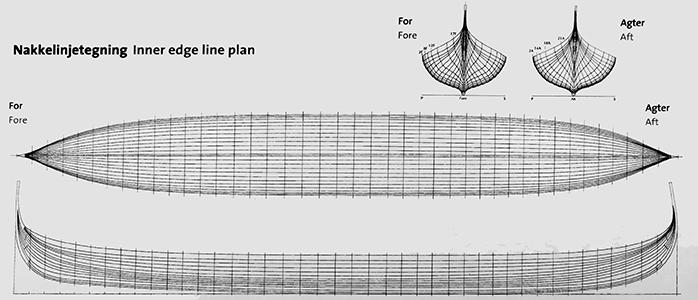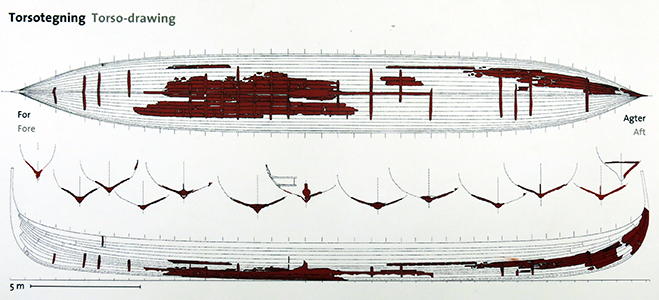Back to Don's Maps
 Back to Archaeological Sites
Back to Archaeological Sites Viking Ships of Roskilde
Five Viking Ships
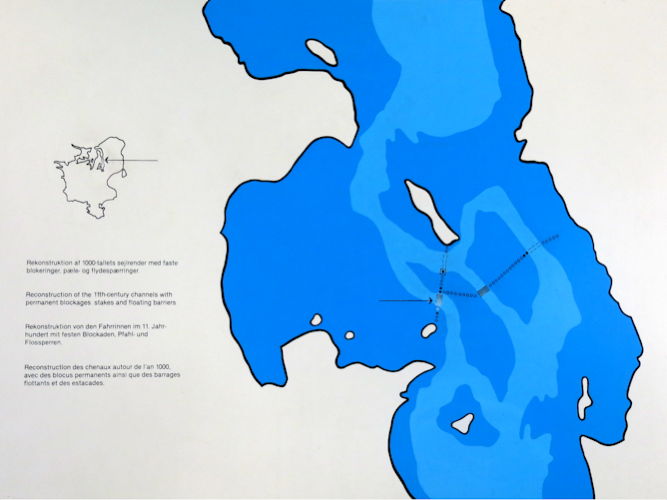
Towards the close of the Viking Age - presumably at some time between 1060 and 1080 AD - the fairways of Roskilde Fjord were blocked by a series of barriers to protect the important trading town of Roskilde from attack by enemy fleets. The five viking ships in the museum come from one of these blockages in the Peberrende channel at Skuldelev, 20 km north of Roskilde. Here, three ships were sunk across the channel and boulders heaped up on top of them. A little later the barrier was strengthened by a further two ships at the spot.
It was at a time when Norwegian Vikings were ravaging Denmark, but we have been unable to link any definite historical event with the blockage.
The blockage manifested itself as a ridge of stones. It had always been known to fishermen in the fjord and local tradition claimed that it contained a ship sunk at the command of Queen Margrethe I, † 1412.
It was not until underwater excavations were carried out by the Danish National Museum between 1957 and 1959 that it was established that the blockage dated from the Viking period and contained not just one but several ships.
Poster and artist: Roskilde Viking Museum, Denmark
Rephotography: Don Hitchcock 2014
Text and source: Roskilde Viking Museum, Denmark
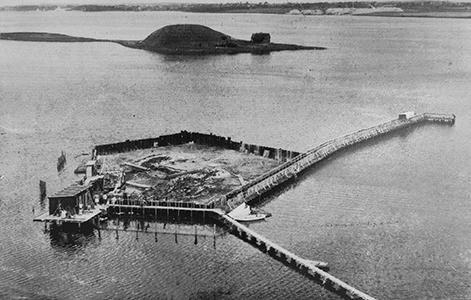
In 1962 a coffer dam of sheet piling was built around the blockage so that it could be drained. In a period of less than four months all five ships were excavated and brought to land in thousands of fragments.
Note the long pier leading from the cofferdam, in shallow water, to a landing stage in deeper water, to enable easier access to the site by boat carrying heavy or bulky items when necessary.
It appears that a pedestrian walkway gave access to the site from the land to the SSW.
Poster and photo: Roskilde Viking Museum, Denmark
Rephotography: Don Hitchcock 2014
Text and source: Roskilde Viking Museum, Denmark
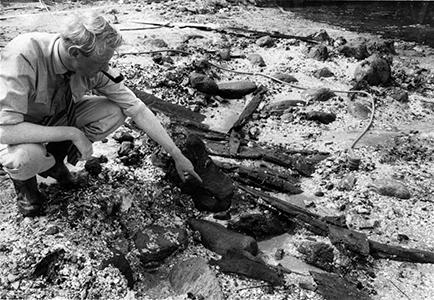
The world of archaeology owes a huge debt to Olaf Olsen, shown here at the excavation site in 1962.
As a direct result of his unstinting efforts, on the 6th of July 1962, the pumps started up at the coffer dam in Roskilde Fjord. Slowly the water level lowered, and eventually five Viking ships came into view at one of the most significant archaeological sites in Denmark. Detailed excavation could begin.
Photo: http://www.vikingeskibsmuseet.dk/nyheder/article/olaf-olsen-holder-festforedrag-om-udgravningen-af-vikingeskibene-i-roskilde-fjord/#.VGkubFdrs8g
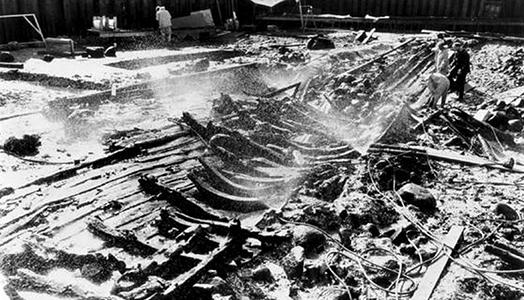
After the cofferdam was pumped out, the salvage work could begin in earnest. The exposed timbers, however, had to be prevented from drying out by mists of water from sprinklers attached to hoses, or they would have powdered into dust.
Diesel pumps were no doubt used to maintain the water pressure night and day.
Photo: The Viking Ship Museum, Denmark
Source: Bennett (2009)
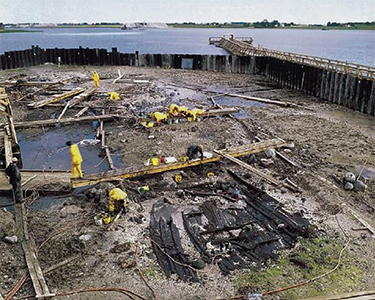
Excavating the Skuldelev Ships within the coffer dam in 1962.
Photo: The Viking Ship Museum, Denmark
Source: Bennett (2009)
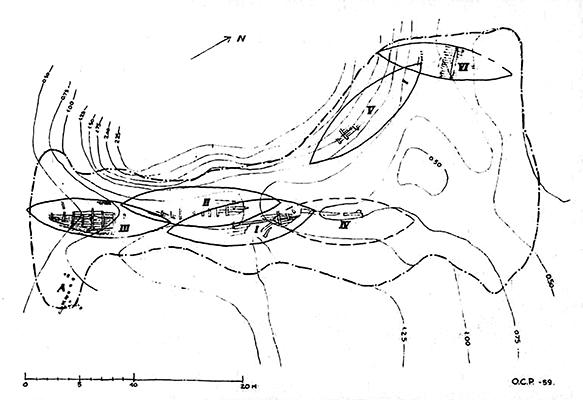
This is the initial map drawn by the archaeologists of the Viking ships off Skuldelev, near Roskilde, before the coffer dam was constructed, and while all the ships were still under water.
They worked under severe difficulties. For many years, Danish fishermen had reported a sunken ship blocking a narrow channel in the fjord leading southward from the Kattegat sea to Roskilde.
Salvaged fragments showed that the wreck was from the Viking period. Lured by these fragments, staff members at the National Museum, headed by Olaf Olsen, took lessons in frogmanship, and in the summer of 1957 embarked on the underwater excavation project.
Note that ships 2 and 4 are now treated as one, ship 2. The designation 'ship 4' has been abandoned.
Photo and text: Palatsky (1962)
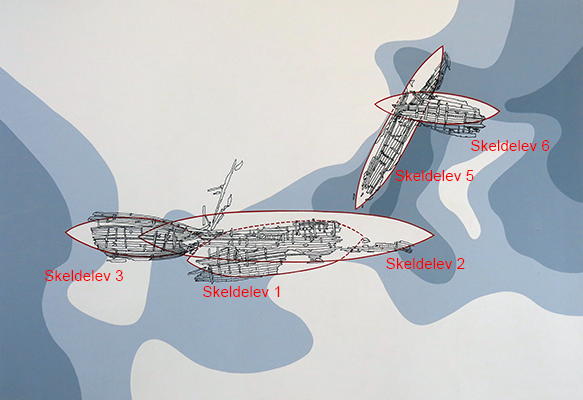
Final map drawn after the coffer dam was built and drained, and the ships were recovered.
(note that contrary to normal practice, on this map the deepest water is shown in the lightest shades, the shallowest water in the darkest shades - Don )
The work of three summers of diving confirmed that the wreck was of Viking origin, from the 9th, 10th, or 11th century. Moreover, the divers found not just one, but possibly six small ships filled with rocks. Some of the vessels lay on top of each other, some in a row.
The amateur frogmen from the National Museum found the fjord wreckage extended one hundred and fifty feet in length, and thirty to fifty feet in breadth, in some places only three to ten feet below the surface. The individual ships averaged forty to sixty feet in length, perhaps ten feet wide and four feet in width.
Poster and artist: Roskilde Viking Museum, Denmark
Rephotography: Don Hitchcock 2014
Source: Roskilde Viking Museum, Denmark
Text: Palatsky (1962)
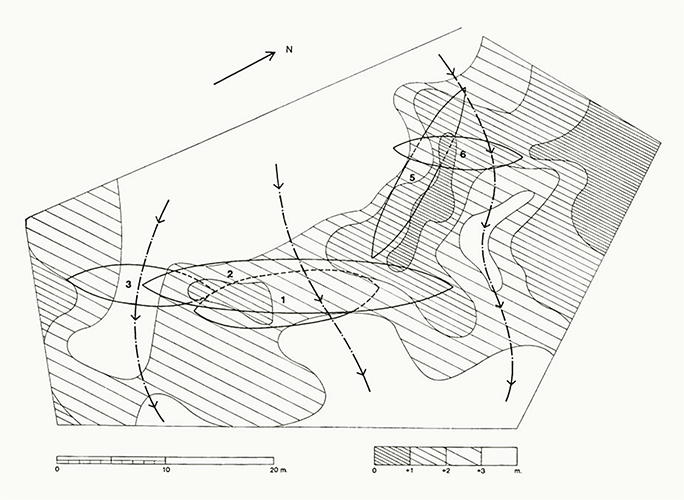
The ships' location in relation to the natural barrier of the Skuldelev navigable channel bottom. The numbers indicate the depth in metres before the sinking of the ships and the arrows mark the three navigable stream furrows.
Photo: after Olsen and Crumlin-Pedersen (1969)
Source and text: http://www.denstoredanske.dk/Danmarks_Oldtid/Yngre_Jernalder/Et_samfund_vendt_imod_havet_800-1050_e.Kr/Med_%C3%A5rer_og_sejl
The explorers dreamed at first of merely throwing a rope around each ship and hauling it up, with the whole project lasting about two weeks. They soon grew wiser. Excavation under water is a painstaking operation. At times, they could work in waist-deep water, using skindivers' goggles but not needing diving apparatus. More often they wore rubberised, watertight suits and laboured below the surface equipped with a full mask and two air cylinders.
They swam along the ships, removing the granite and flint stones, some weighing two hundred pounds, which they piled on a raft and hauled away for dumping in deep water. They cleared away seaweed, shells and mud, aided by a helper on a pontoon anchored near the wrecks.
The helper watched their lifelines and airtubes, and kept their fire hose working properly. The fire hose was their most important tool. The usual aids to archaeology-shovel, trowel, and brush-proved useless, merely stirring up the mud and blinding the diggers. With the fire hose they could remove debris from the site without complete loss of visibility. The hose poured a gentle stream under water, so that the ships weren't further disintegrated by the digging. Also, the divers could manipulate a full-pressure backwash from the hose to propel themselves horizontally through the water.
But visibility remained a problem. Mud would be churned, and they would have to work blind for a few minutes, then wait motionless until the water cleared. Floating seaweed altered the appearance of the bed almost daily. 'With all due respect to the Roskilde fjord,' Mr. Olsen said, 'it lacks the clarity of the Mediterranean.'
So to keep their bearings, they stretched a steel wire marked at metre intervals along the blockage, and used this as a guide with fixed points on land to draw a map of the project site. For this task they sketched with a soft pencil on special waterproof paper stretched in a plastic frame which was strapped to the diver's forearm. The map then served as a blueprint as they continued to toil in the murky depths.
To prevent portions of the wrecks from floating away with the current, only small parts were exposed at a time.
Text: Palatsky (1962)
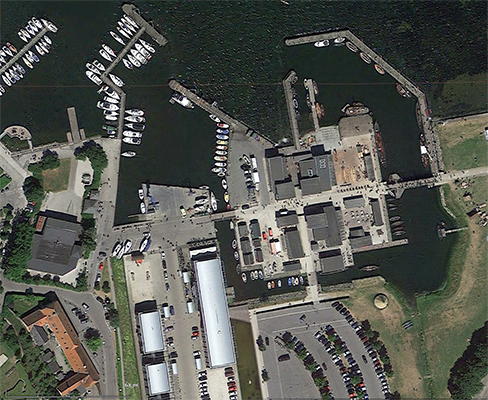
A recent satellite photograph shows the museum on the man-made island completed in 1997.
The museum was originally constructed in 1969 in order to store the five Skuldelev ships. It was decided in the 1990s to expand the museum itself, as well as provide display space outside on the harbour for Viking ship replicas. During the process of digging the three canals around the museum to hold Viking ship replicas and other exhibits, another nine Viking ships were found, including Roskilde 6, the largest Viking longship ever found.
This ship, too big once conservation was complete to be housed at the museum itself, has now been on public display in Copenhagen, London, and Berlin during 2013/2014.
Photo: Google Earth 2013.07.20
The Five Skuldekev Ships
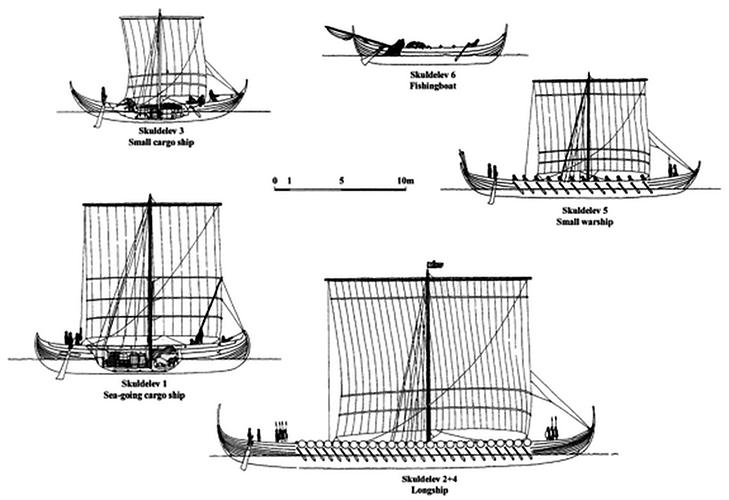
The Skuldelev ships, representing the two warships (wrecks 2+4 and 5), two cargo carriers (wrecks 1 and 3), and a fishing vessel (wreck 6).
Shown here at the same scale so that the viewer can get some idea of their relative sizes.
Outline reconstruction: M. Gøthche and E. Andersen
Photo and text: Hocker et al. (2004)
Skuldelev 1
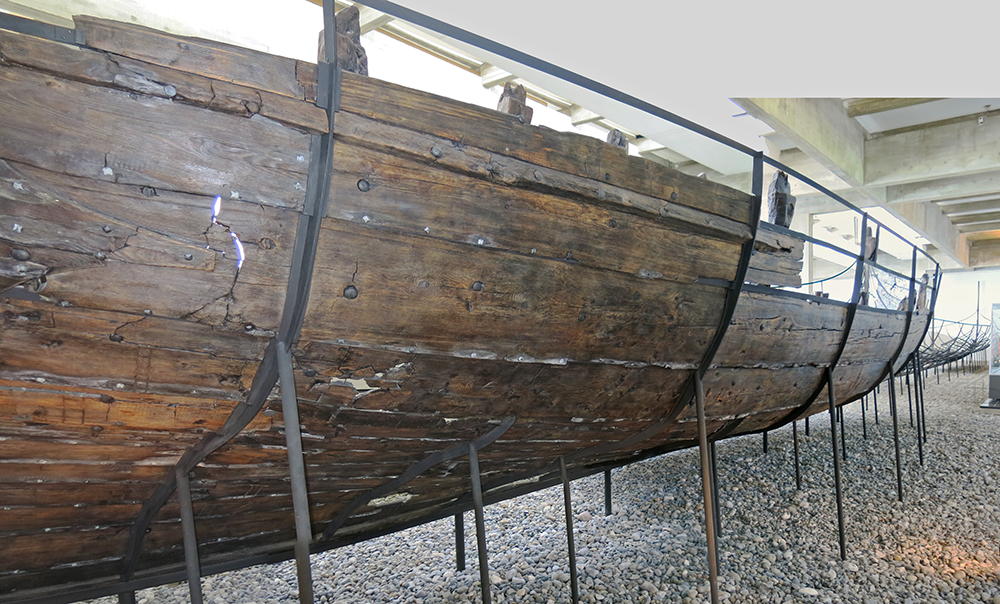
Skuldelev 1 - The ocean-going trader
The find of the five ships was significant not just because it consisted of five different types of ships but because the ships provided a good indication of the impressive range of activity of the Viking-age shipbuilders.
Photo: Don Hitchcock 2014
Source and text: Roskilde Viking Museum, Denmark
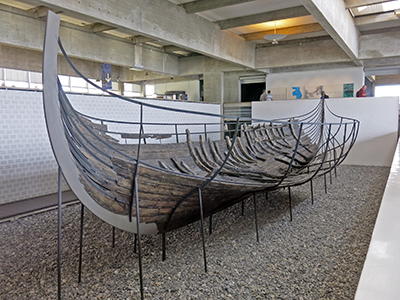
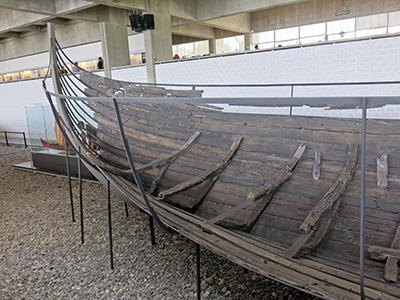
Skuldelev 1 - The ocean-going trader
Photo: Don Hitchcock 2014
Source: Roskilde Viking Museum, Denmark
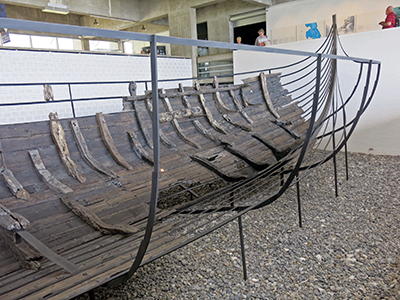
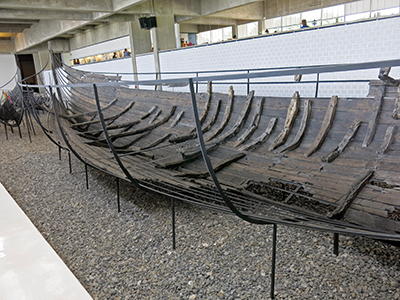
Skuldelev 1 - The ocean-going trader
Photo: Don Hitchcock 2014
Source: Roskilde Viking Museum, Denmark
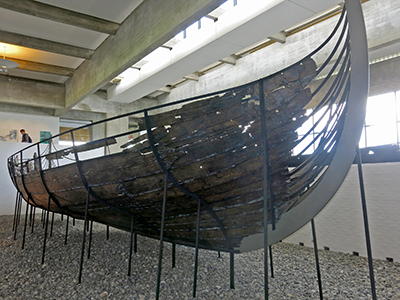
Skuldelev 1 - The ocean-going trader
Photo: Don Hitchcock 2014
Source: Roskilde Viking Museum, Denmark
Skuldelev 1
| Design Element | Details |
|---|---|
| Material | pine, oak, and lime |
| Length | 15.84 metres |
| Breadth | 4.8 metres |
| Draught | 1 metre |
| Displacement | 21 tons |
| No. of oars | 2-4 |
| Crew | 6-8 men |
| Sail Area | 90 m2 |
| Average Speed | 5-7 Knots |
| Top Speed | ca 13 Knots |
| Dating | ca 1030 AD |
| Place of Construction | Western Norway |
| Preserved | ca 60% |
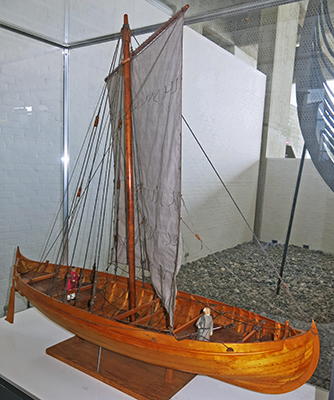
Skuldelev 1 - The ocean-going trader
Photo: Don Hitchcock 2014
Source: Roskilde Viking Museum, Denmark
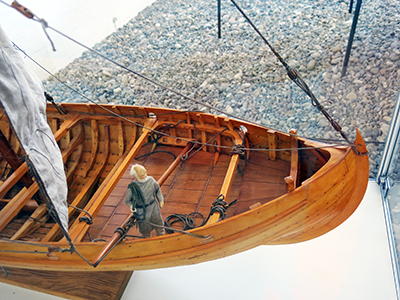
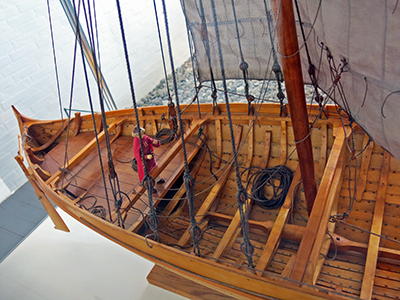
Skuldelev 1 - The ocean-going trader
These images show the layout of the interior of the ship, as well as displaying the craftsmanship and attention to detail of the model maker.
Photo: Don Hitchcock 2014
Source: Roskilde Viking Museum, Denmark
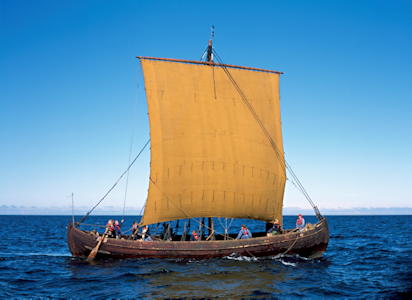
Ottar
Reconstruction of Skuldelev 1, an ocean-going trader from the Viking Age, 1030. Ottar was built of oak, pine and lime at the museum boatyard in 1999-2000. Like Skuldelev 6, the original Skuldelev 1 was built in Sognefjord in Norway around the year 1030. Common to both ships is the special longitudinal change in angle along the bottom of the boat under the waterline, the chine, resulting from the almost vertical planking midway in the otherwise curved cross-section. Presumably the purpose was to provide more resistance to leeway in a vessel with shallow draught and at the same time reduce friction and turbulence by creating two parallel spirals in the water flow under the bottom to increase the speed and make steering easier.
Typical of this ship is its robust and full form that gives both great seaworthiness and large cargo-carrying capacity. Amidships there are two capacious holds and, for and aft, large manoeuvre decks. It must be the type of ocean-going ship the Vikings called a 'knarr' and which, according to written sources, was the only type of ship that sailed to Greenland. This small 'knarr' is hardly likely to have made such a voyage even though the 'Saga Siglar', a Norwegian reconstruction, visited Greenland on a round-the-world voyage in 1984-86. The original ship was most probably an 'austfarerknarr"' (a 'knarr' that sailed eastwards) which carried cargo across the North Sea and the Baltic, two large areas of unsheltered water where seaworthiness is at a premium and where a draught of less than 150 cm when loaded enables it to negotiate shallow bays and rivers.
Today Ottar sails with a sail made of flax, but originally the sail was made of wool. The manufacture of the 90 metres2 woollen sail for Ottar was a project in itself during which assistance was received from textile researchers in Denmark, Norway, Sweden, England and Scotland. A great deal of the practical work in recreating the sail was carried out at the special exhibition organised by the Viking Ship Museum, 'Sails', in 1999. The wool came from as many as 200 'Spelsauer' sheep - descendants of Norwegian wild sheep. Each one of these rather small sheep yielded about 500 g of usable wool. This had to be spun very tautly and woven incredibly densely to achieve a woollen material which was suitably windproof and durable. To make sure the sail repelled water and that it was even more wind-proof, the finished-woven sail was treated with raw ochre and a mixture of horse mane fat and water in the ratio of 1:10. The mixture was boiled, cooled down and then rubbed into the sail using glass stones. It is interesting to note that it was the ochre that made the sail tight - and yellow - not the fat. After the sail had been in use for a certain time beef suet was kneaded into the front side to make the surface smooth.
The rigging rope work is also made of authentic materials. The standing rigging that braces the mast is of hemp while the running rigging for the sail is made from horse hair. As an experiment, a little linden bast rope has been used for the centre sheets ('prierne') and for the ribands that fasten the sail to the yard using reef knots ('råbåndsknob').
When Ottar and its crew are fully 'run in', the ship will be used mainly for sea trials over longer distances in order to research the speed and seaworthiness of the ocean-going trader in practice.
The principal propulsion force of the 'knarr' is provided by a square sail of 90 m2, but for manoeuvring in harbour and in calm weather it can be rowed with four long oars. The cargo-carrying capacity is 35 cubic metres, or about 20 tons.
Photo and text: http://www.vikingeskibsmuseet.dk/en/ottars-rejse/the-trader-ottar/#.VF2At_SUeXM
Skuldelev 2
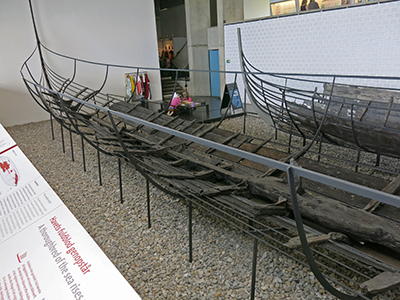
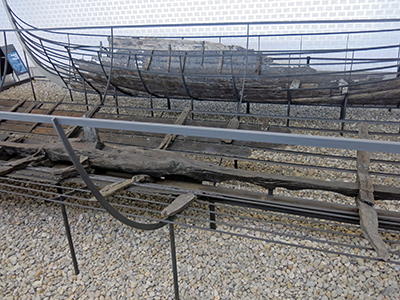
Skuldelev 2
Skuldelev 2 is an oak-built, seagoing warship. It is a longship, possibly of the skeid type. It is approximately 30 m long and 3.8 m wide, and would have had a crew of 70-80.
Photo: Don Hitchcock 2014
Source: Roskilde Viking Museum, Denmark
Text: Wikipedia
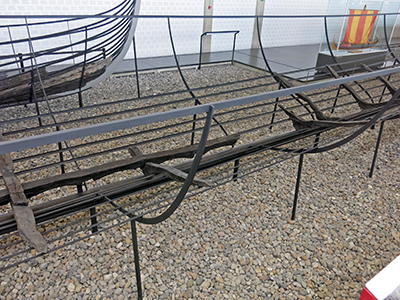
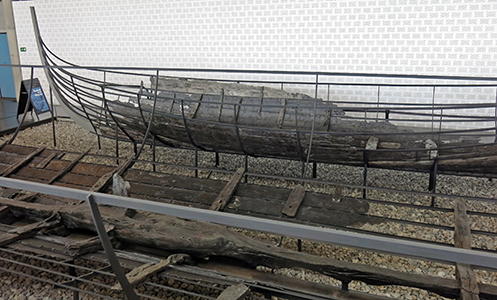
Skuldelev 2
Dendrochronology showed that the ship was built in the Dublin area around 1042. The shape of the ship would have allowed for great speed, up to 15 knots (28 km/h) with a rowing crew of 60 and more while under sail. It is one of the longest Viking-ships ever found.
Photo: Don Hitchcock 2014
Source: Roskilde Viking Museum, Denmark
Text: Wikipedia
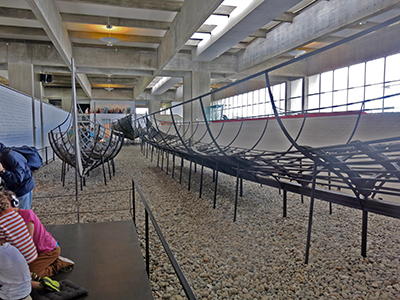
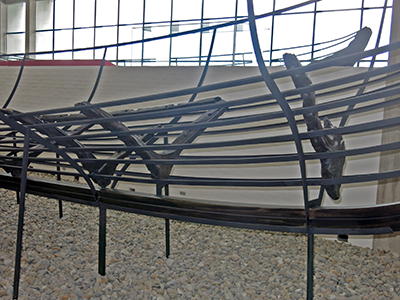
Skuldelev 2
A ship was deemed seaworthy if it only needed bailing three times in two days. Sheep wool and tar was used for caulking between the planks.
Photo: Don Hitchcock 2014
Source: Roskilde Viking Museum, Denmark
Text: Wikipedia
Skuldelev 2
| Design Element | Details |
|---|---|
| Material | oak |
| Length | ca 30 metres |
| Breadth | 3.8 metres |
| Draught | 1 metre |
| Displacement | 26 tons (fully equipped) |
| No. of oars | 60 |
| Crew | 65-70 men |
| Sail Area | 112 m2 |
| Average Speed | 6-8 Knots |
| Top Speed | 13-17 Knots |
| Dating | ca 1042 AD |
| Place of Construction | Dublin, Ireland |
| Preserved | ca 25% |
Skuldelev 2
Line Plan and remains found.
Draftsman: Sune VIllum-Nielsen, Denmark
Registrar: E Andersen
Poster: Roskilde Viking Museum, Denmark
Rephotography: Don Hitchcock 2014
Source: Roskilde Viking Museum, Denmark
( My thanks to David King for the correct identification of these plans - Don )
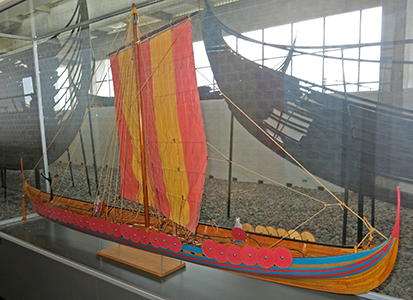
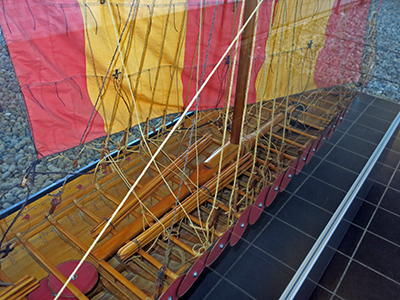
Skuldelev 2 - The Seagoing Warship
Photo: Don Hitchcock 2014
Source: Roskilde Viking Museum, Denmark
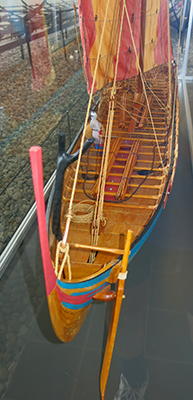
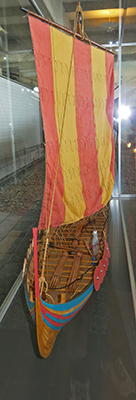
Skuldelev 2 - The Seagoing Warship
Photo: Don Hitchcock 2014
Source: Roskilde Viking Museum, Denmark
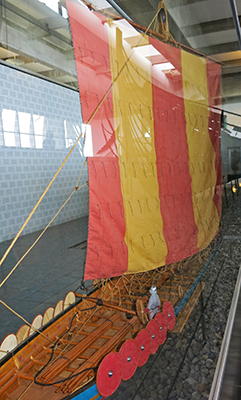
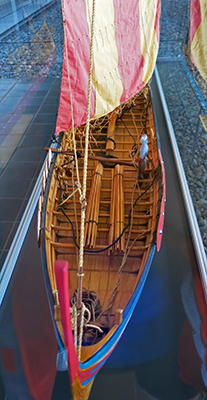
Skuldelev 2 - The Seagoing Warship
Photo: Don Hitchcock 2014
Source: Roskilde Viking Museum, Denmark
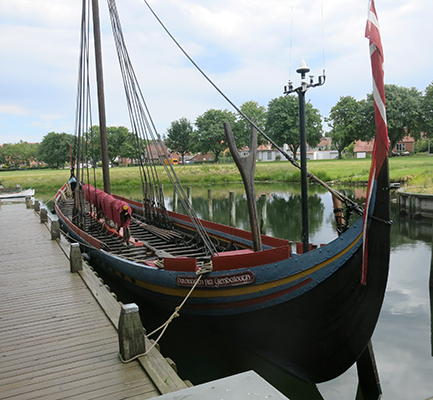
Havhingsten fra Glendalough ('Sea Stallion from Glendalough') is a reconstruction of Skuldelev 2. The original ship was built around 1042 near Dublin with oak from Glendalough, Wicklow, Ireland, hence the ship's name. The reconstruction was built at the shipyard of the Viking Ship Museum in Roskilde from 2000 to 2004.
Havhingsten fra Glendalough is a reconstruction of the second longest Viking longship that has been found so far, the longest being Roskilde 6, found during the excavations for the extension of the Roskilde Museum. The 25 ton vessel was finished in 2004 after 44 000 man hours of work, if we include the time for tar production, blacksmithing, rope making, sail making etc.
150 cubic metres of wood was used for the ship. To this can be added (for the original) the 18 cubic metres of pinewood used to produce tar as well as 4 500 one-metre-long, arm-thick lime branches stripped for bast along with large quantities of charcoal and bog iron ore to produce about 400 kg of raw iron, 600 horsetails for ropes, etc.
Photo: Don Hitchcock 2014
Source: Roskilde Viking Museum, Denmark
Text: Wikipedia and http://www.vikingeskibsmuseet.dk/en/research/ship-reconstruction/skuldelev-2/#.VGwNsFdrs8g
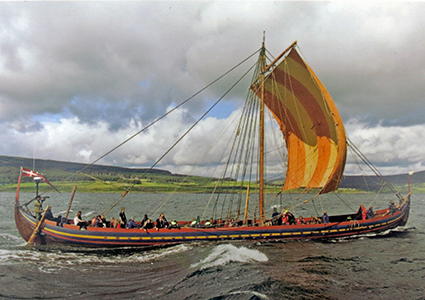
Havhingsten fra Glendalough in sea trials.
The provisional sail is made of cotton; it would have required 200 kg of processed flax or wool to manufacture a sail in the original materials.
The original ship had impressive rigging. The 13 m long keelson and the many keelson knees illustrate the ship’s advanced technical level and daring construction. Everything is minimised in dimension and weight without weakening the strength of the construction. Calculations of the ship's hull-rigging-rudder balance formed the basis for the construction of the 14.5 m high mast, a 12 m long yard and a square sail of 112 m2.
Photo: Roskilde Viking Museum, Denmark
Rephotography: Don Hitchcock 2014
Source: Roskilde Viking Museum, Denmark
Text: http://www.vikingeskibsmuseet.dk/en/research/ship-reconstruction/skuldelev-2/#.VGwNsFdrs8g
Skuldelev 3
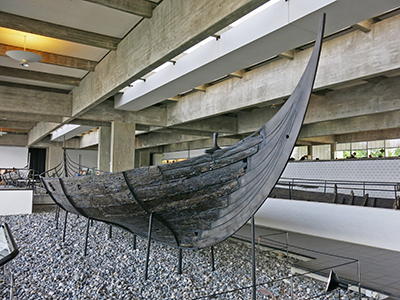
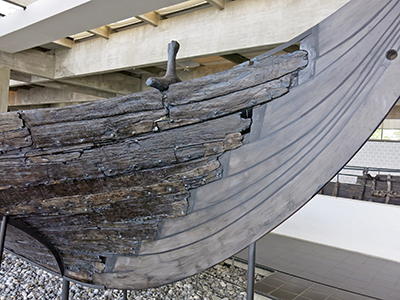
Skuldelev 3
The five ships are known as the Skuldelev ships, since they were recovered from Peberrenden near Skuldelev.
A reproduction of Skuldelev 3, called Roar Ege, was built.
Photo: Don Hitchcock 2014
Text and source: Roskilde Viking Museum, Denmark
Additional text: Wikipedia and http://thevikingships.weebly.com/byrding-ships.html
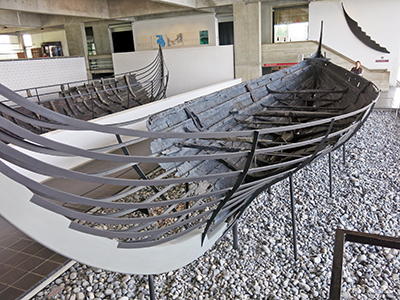 This is Skuldelev 3, a 14 m long and 3.3 m wide cargo ship, possibly of the Byrding type. It is made from oak, and was constructed somewhere in Denmark. It would have been well-suited to shorter journeys in Danish waters and the Baltic Sea.
This is Skuldelev 3, a 14 m long and 3.3 m wide cargo ship, possibly of the Byrding type. It is made from oak, and was constructed somewhere in Denmark. It would have been well-suited to shorter journeys in Danish waters and the Baltic Sea.
Photo: Don Hitchcock 2014
Text and source: Roskilde Viking Museum, Denmark
Additional text: Wikipedia and http://thevikingships.weebly.com/byrding-ships.html
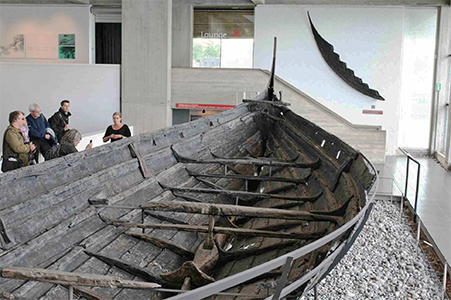
A good shot from a high angle of the interior of Skuldelev 3.
Photo: © Charlotte Paturel
Source: http://www.top-parents.fr/voyages-et-vacances/voyages-et-vacances/en-vacances-chez-les-vikings-danemark.html
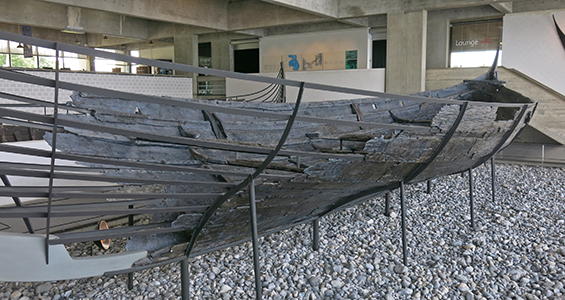
Skuldelev 3 would have held a crew of 5-6 and could reach a top speed of 8.5 knots (16 km/h) under sail.
Photo: Don Hitchcock 2014
Text and source: Roskilde Viking Museum, Denmark
Additional text: Wikipedia and http://thevikingships.weebly.com/byrding-ships.html
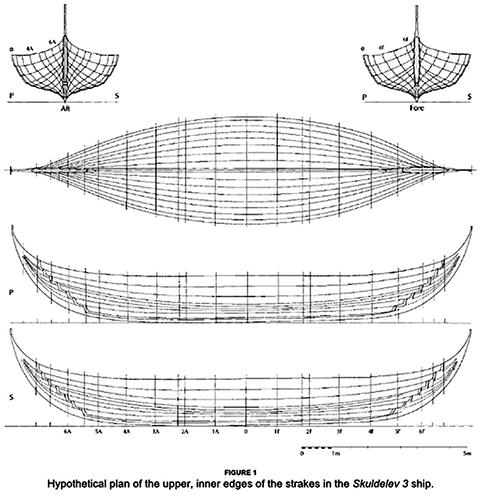
Hypothetical plan of the upper, inner edges of the strakes in the Skuldelev 3 ship.
Draftsman: Sune VIllum-Nielsen, Denmark, © The Viking Ship Museum, Denmark
Source: Bennett (2009)
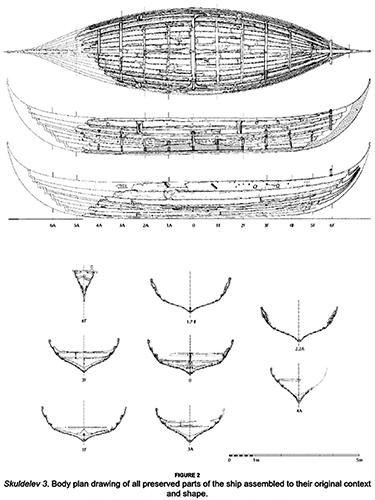
Body plan drawing of all preserved parts of the ship assembled to their original context and shape in the Skuldelev 3 ship.
Draftsman: Sune VIllum-Nielsen, Denmark, © The Viking Ship Museum, Denmark
Source: Bennett (2009)
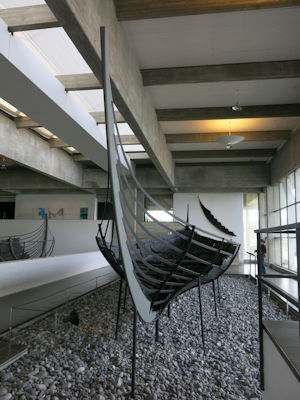
Skuldelev 3
Byrding Ships were light freight ships. These ships were more maneuverable than the Knarr ships. They were light enough to be pulled into shore. The Byrding Ships were also used to transport goods and merchants quickly. These were more reliant on oars than the similar heavy freight ships.
Wreck 3 is a small, elegant trading and transport vessel, possibly of the Byrding type. The ship was built of Danish oak. It had decks of loose planks fore and aft and an open hold amidships with room for about 4 tons of cargo. The ship had a crew of 5-8 men.
The ship may have been used by a farmer for sailing in Danish coastal waters and in the Baltic. Wind was the most important method of powering the ship, but oars could be used when manoeuvring or when travelling short distances in calm weather. An average speed of 4-5 knots could be held in favourable winds. Roar Ege, a reconstruction of Skuldelev 3 built by the Viking Ship Museum, has sailed at a top speed of 8.5 knots. Roar Ege is on display at the museum harbour.
Photo: Don Hitchcock 2014
Text and source: Roskilde Viking Museum, Denmark
Additional text: Wikipedia and http://thevikingships.weebly.com/byrding-ships.html
Skuldelev 3
| Design Element | Details |
|---|---|
| Material | oak |
| Length | 14 metres |
| Breadth | 3.3 metres |
| Draught | 0.9 metre |
| Displacement | 9.6 tons |
| Cargo Capacity | 4.6 tons |
| No. of oars | 5 oar ports |
| Crew | 5-8 men |
| Sail Area | 45 m2 |
| Average Speed | 4-5 Knots |
| Top Speed | 8-10 Knots |
| Dating | ca 1042 AD |
| Place of Construction | Denmark |
| Preserved | ca 75% |
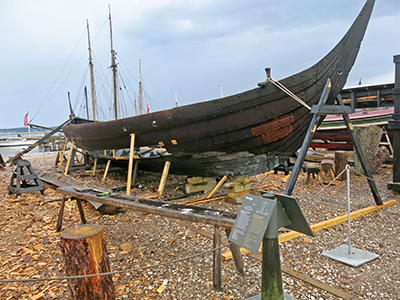
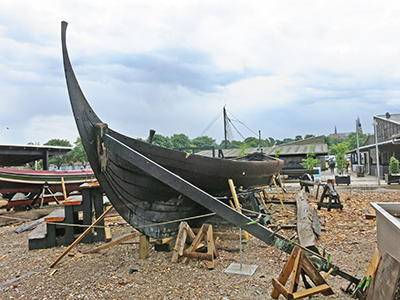
Skuldelev 3 reconstruction, Roar Ege undergoing repairs in the shipyard.
Roar Ege was the first of the Skuldelev ships to be reconstructed and was launched in 1984. 30 years later, and the hull is starting to show its age. During the summer of 2014, the boatbuilders replaced several of the timbers, which were worn, and some of the iron nails which had rusted.
Photo: Don Hitchcock 2014
Text and source: Roskilde Viking Museum, Denmark
Additional text: http://www.vikingeskibsmuseet.dk/en/news/archive/2014/august/article/summer-projects-at-the-viking-ship-museums-boatyard-1/#.VF1e6fSUeXM
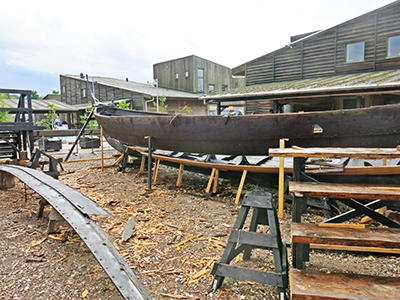
Roar Ege is a reconstruction of a trading ship from the Viking period, 1030. Built of oak at the museum boatyard in 1984 as a reconstruction of the small trading ship Skuldelev 3. The original ship was used by merchants to sail freight along the Danish coasts and across the southern Baltic. It is both very sturdy and light with an extremely fine finish; all wood that merely adds weight without strength is pared away. The ship's main means of propulsion is a square sail.
Photo: Don Hitchcock 2014
Text and source: Roskilde Viking Museum, Denmark
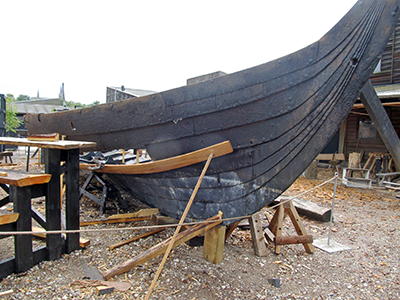 Skuldelev 3 reconstruction, Roar Ege undergoing repairs in the shipyard.
Skuldelev 3 reconstruction, Roar Ege undergoing repairs in the shipyard.
Oars: 6 oars for use in harbours and in calms.
Length: 14 metres. Breadth: 3.4 metres. Draught: 0.85 metres
Sail area 46 metres2
Load capacity: 5 tons
Crew: 5-8 men
Maximum speed, sail: 8.5 knots
Maximum speed, oars: 3.5 knots
Photo: Maria Hitchcock 2014
Text and source: Roskilde Viking Museum, Denmark
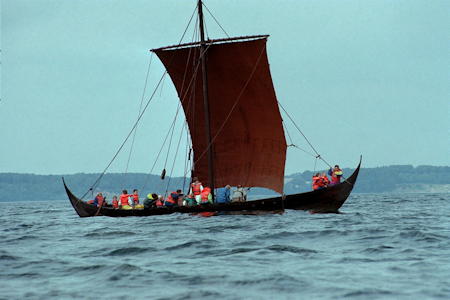
Roar Ege under way.
Photo: http://hotel.dds.dk/absalon/skinfaxe/billeder/barsoe1/index.html
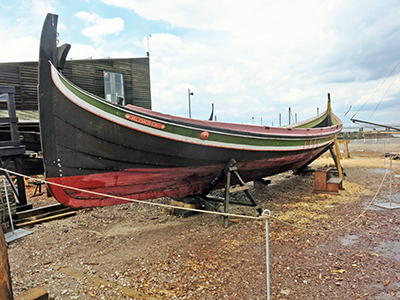
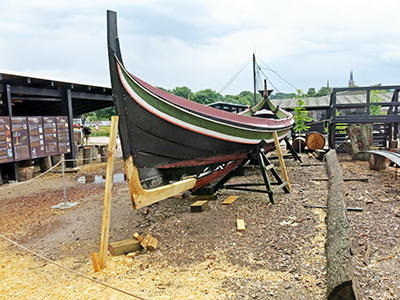
Beside Roar Ege lies Rana, a 10m long Nordland boat from 1892 - the oldest traditional boat in the Museum's boat collection.
Despite the 800 year gap between the construction of Skuldelev 3 and Nordland boats like Rana, the two vessels share a special connection. Nordland boats were primarily used for winter fishing around Lofoten and Vesterålen, north of the Arctic Circle in Norway. They were built following construction principles that had remained relatively unchanged since the Viking Age. They were clinker built and had square sails, and were therefore also known as 'The last Vikings'.
Photo: Don Hitchcock 2014
Source: Roskilde Viking Museum, Denmark
Additional text: http://www.vikingeskibsmuseet.dk/en/news/archive/2014/august/article/summer-projects-at-the-viking-ship-museums-boatyard-1/#.VF1e6fSUeXM
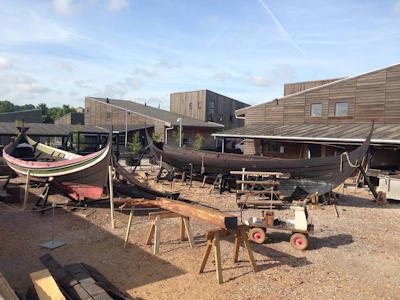
At the end of the 19th century and into the 20th century, fishing boats in southern Scandinavia gradually stopped using square sails and had instead adopted sprit and gaff sails. This was not the case with the Nordland boats: the majority retained not only the shape of their hulls, but also rig design and handling.
Experimental archaeological breakthrough
When the Museum acquired Rana, no-one had any idea that this boat would be the key to understanding the design and use of Viking Age square sails. Holes in Rana's hull, which were used to secure the foremost corner of the sail (also called the tack), matched the holes which had been found on the hull of the original ship find, Skuldelev 3. This discovery was the first vital step towards reconstructing the rigging of Viking Age ships. Roar Ege and Rana became the foundation on which the Museum's experimental archaeological research programme would be built.
Rana is 122 years old and the years have taken their toll on the hull. The boatbuilders will be replacing some of the planks and frames.
Photo and text: http://www.vikingeskibsmuseet.dk/en/news/archive/2014/august/article/summer-projects-at-the-viking-ship-museums-boatyard-1/#.VF1e6fSUeXM
Rana
From an interpretation board at the Roskilde shipyard:
Storottring from Nordland, Norway, 1892.
This Nordland boat was built of spruce at Hemnessberget in Ran Fjord for winter fishing for cod around the Lofoten Islands and Vesteralen in Northern Norway. The Nordland boat and its neighbour from Afjord in North Trondelag were called 'The Last Vikings', because the boats, with their picturesque hulls and square sails, were used right up until around 1920. The boat is rigged with a square sail and a topsail.
Oars: 10
Length: 10.8 metres. Breadth: 2.7 metres
Draught: 0.55 metres
Sail Area: 33 metres2
Crew: 5 men
Maximum speed, sail: 12.5 knots
Maximum speed, oars: 3.5 knots
Skuldelev 4
When first found it was thought that there were six ships in the group. It was subsequently found that Skuldelev 4 was part of Skuldelev 2, so the remains previously attributed to Skuldelev 4 were re-assigned to Skuldelev 2, and the name Skuldelev 4 was abandoned.
Skuldelev 5
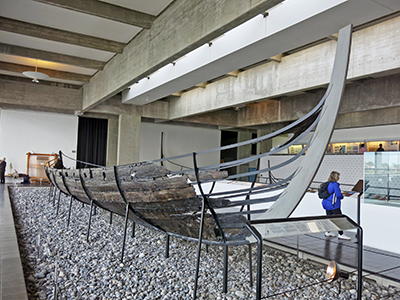
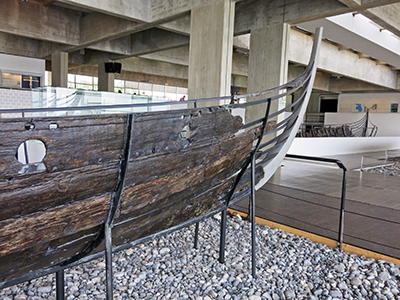 Skuldelev 5
Skuldelev 5
The small longship
Sebbe Als is a modern reconstruction.
Wreck 5 is a smaller warship, possibly of the Snekke type.
The ship was built of Danish oak, ash, and pine, partly by reusing timber from other ships. With 13 pairs of oars and about 30 warriors, it belonged to the 13-sessers, the smallest longship in a war fleet.
Photo: Don Hitchcock 2014
Source: Roskilde Viking Museum, Denmark
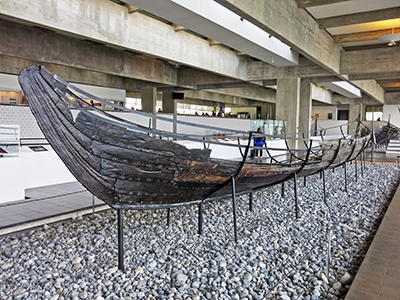
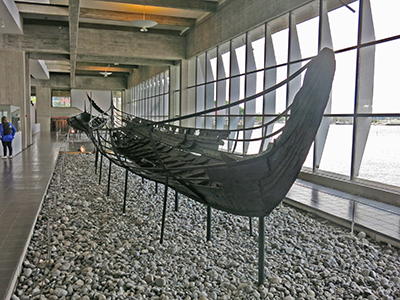 Skuldelev 5
Skuldelev 5
Along the sheerstrake there are fragments of the shield-rack, on which shields were placed, and on the sixth strake on the port side aft, carved decoration can be seen.
The ship was ideal for sailing in Danish coastal waters, and through the short, choppy waves of the Baltic. An average speed on longer voyages would have been 6-7 knots in favourable winds, with a top speed of about twice that. Helge Ask, a reconstruction of Skuldelev 5 built by the Viking Ship Museum, is on display at the museum harbour.
Photo: Don Hitchcock 2014
Source: Roskilde Viking Museum, Denmark
Skuldelev 5
| Design Element | Details |
|---|---|
| Material | oak, pine, ash, alder |
| Length | 17.3 metres |
| Breadth | 2.5 metres |
| Draught | 0.6 metres |
| Displacement | 7.8 tons |
| No. of oars | 26 |
| Crew | ca 30 men |
| Sail Area | 46 m2 |
| Average Speed | 6-7 Knots |
| Top Speed | ca 15 Knots |
| Dating | ca 1030 AD |
| Place of Construction | Denmark |
| Preserved | ca 50% |
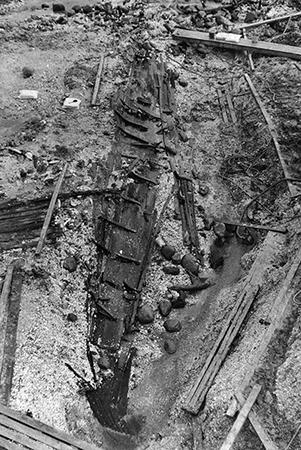
Skuldelev 5 was found during underwater investigations by divers in Peberrenden, Roskilde Fjord in 1959, and was excavated together with the other Skuldelev ships in 1962. The ship's port side in particular is well preserved and the vessel could be reconstructed as an oar-powered ship, 17.3 m long, 2.47 m wide and 1.16 m deep midships, and with 13 pairs of oars.
Such a ship is also called a 13-sessa, or thirteen seater, after the 13 thwarts providing seating for the 26 rowers. Scanty remains of the keelson show that it had also been equipped with a mast and sail. Its construction date has been established with the aid of dendrochronological investigations as being shortly after AD 1024.
These investigations also revealed that the ship was built within the borders of medieval Denmark.
Photo and text: http://www.vikingeskibsmuseet.dk/en/the-sea-stallion-past-and-present/longships-magnified/the-archaeological-sources/skuldelev-5/#.VGfgWFdrs8g
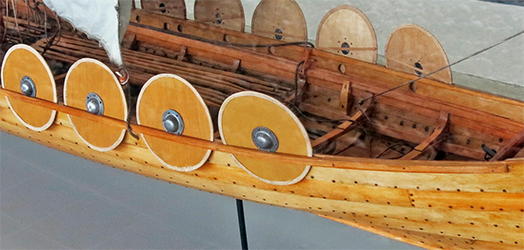
A wooden 'list' used as a shield rack (a narrow strip of wood cut from the edge of a board, with spacers to provide a narrow gap between the list and the ship, shown here) running along the outside of the gunwale behind which the crew could place their shields, shows that the vessel Skuldelev 5 was undoubtedly a warship. It is an example of the smallest category of warship, a snekkja, as mentioned in written sources from late Viking times and the early Middle Ages.
Photo and text: http://www.vikingeskibsmuseet.dk/en/the-sea-stallion-past-and-present/longships-magnified/the-archaeological-sources/skuldelev-5/#.VGfgWFdrs8g
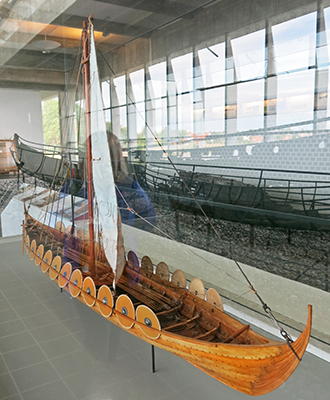
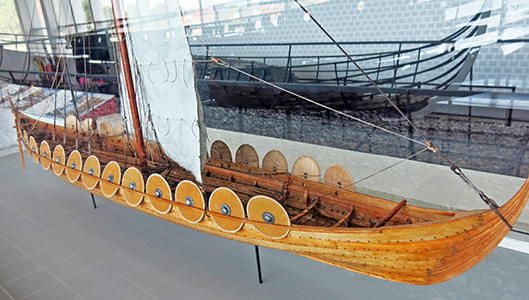
Skuldelev 5
Model.
Photo: Don Hitchcock 2014
Source: Roskilde Viking Museum, Denmark
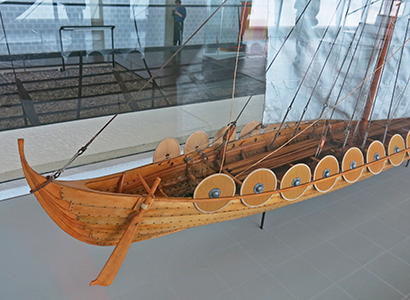
Skuldelev 5
Note the steering oar or rudder on the starboard side of the stern of the vessel.
Photo: Don Hitchcock 2014
Source: Roskilde Viking Museum, Denmark
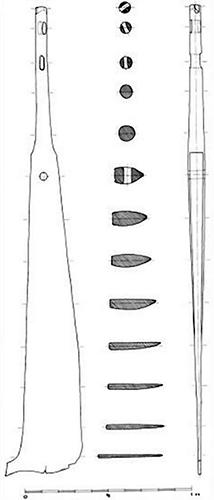
The asymetrical side rudder (with cross sectionals) was based on one found in northeast Jutland in 1958. It is known as the Vorsa rudder.
Photo: The Viking Ship Museum, Denmark
Source and text: Bennett 2009
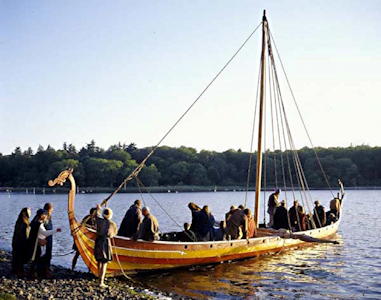
Skuldelev 5 replica - Helge Ask.
Photo: http://www.hum.au.dk/moesgaard/vikingemuseet/kongsvang.htm#
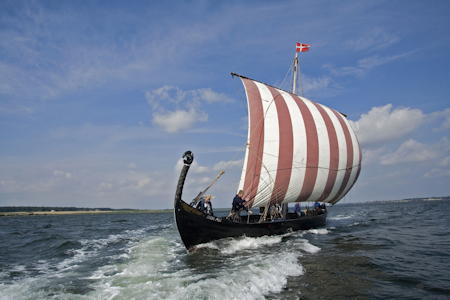
Skuldelev 5 replica - Sebbe Als.
Sebbe Als, as the boat is called, is built as a replica of wreck number 5 found in Roskilde Fjord, where it sank sometime in the 11th century. It is a fast warship with a long and slim body with 24 oars and a relatively large sail. It can fit up to 30 people.
The ship is owned and operated by an independent society, who built the boat in the period 1967 – 1969, a few years after the finds in Roskilde. The ship, which was launched and named Sebbe Als in 1969, was built according to the drawings of the original ship and by using the same tools as the 'old vikings'.
Photo:
http://hejsonderborg.dk/viking-for-a-day-help-launch-a-viking-warship/sebbe-for-sejl-a1-img_0248/
Text: http://hejsonderborg.dk/viking-for-a-day-help-launch-a-viking-warship/
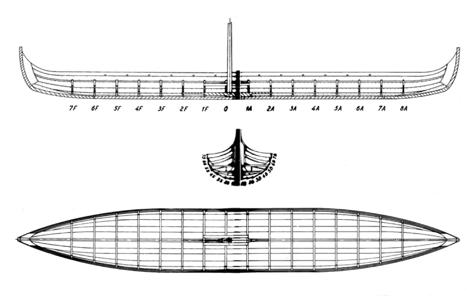
Skuldelev 5 replica - Sebbe Als.
Line drawing of the ship.
Every spring Sebbe is checked, repaired and prepared for the season, and volunteers are always welcome.
Photo: Steen Weile, Notmark, Denmark.
Permission: Creative Commons Attribution 3.0 Unported licence
Skuldelev 6
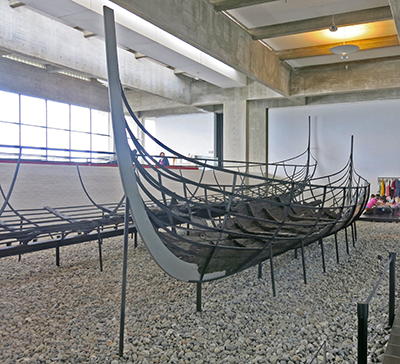
Skuldelev 6 is a combined rowing and sailing vessel probably built for fishing and whaling or seal hunting. The ship was built of pine planks near Sognefjord in Norway. Later, an extra plank was added to increase the height of the side in order to transport more efficiently cargoes of fish, other trading goods or people.
Photo: Don Hitchcock 2014
Source: Roskilde Viking Museum, Denmark
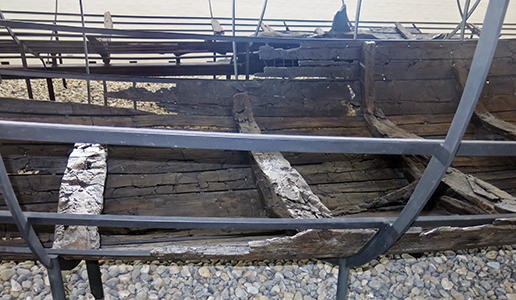
Skuldelev 6
During the alteration, the original rowlocks were removed and the number of oars reduced. The conversion suggests that the ship was probably used more for transport and less for fishing, sailing with a smaller crew.
Photo: Don Hitchcock 2014
Source: Roskilde Viking Museum, Denmark
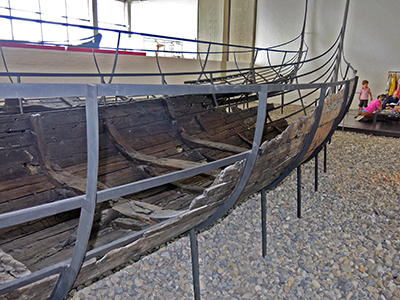
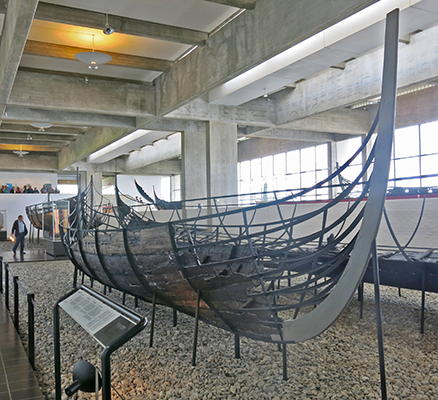
Skuldelev 6
The bottom of the hull had been repaired with oak planks from southern Scandinavia before the ship was scuttled.
Kraka Fyr, a reconstruction of Skuldelev 6 built by the Viking Ship Museum, is on display at the museum harbour.
Photo: Don Hitchcock 2014
Source: Roskilde Viking Museum, Denmark
Skuldelev 6
| Design Element | Details |
|---|---|
| Material | pine, birch, oak |
| Length | 11.2 metres |
| Breadth | 2.5 metres |
| Draught | 0.5 metres |
| Displacement | 3 tons |
| No. of oars | 14 |
| Crew | 5-15 men |
| Sail Area | 26.5 m2 |
| Average Speed | 4-5 Knots |
| Top Speed | 9-12 Knots |
| Dating | ca 1030 AD |
| Place of Construction | Western Norway |
| Preserved | ca 70% |
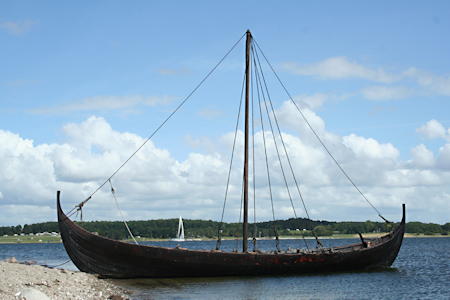
Kraka Fyr, a reconstruction of Skuldalev 6, shown here in Roskilde Fjord in Denmark, 10th August 2008.
Photo: Benjamin Asmussen
Permission: Creative Commons Attribution-Share Alike 3.0 Unported license.
The reasons for the sinking of the Skuldelev Ships
There are no records from the time when the Skuldelev ships were scuttled in the natural channel, Peberrenden (1060 - 1080 AD) that tell of an assault on Roskilde. Nevertheless, an historical account, a letter from Pope Gregory VII to the Norwegian king, Olav Kyrre does suggest that an attack on Denmark was imminent.
The pope had warned that the brothers of King Harald Hen of Denmark, Canute and Erik, (later kings in their own right) who had sought sanctuary with Olav Kyrre, should not be aided in waging war on King Harald Hen, since such a war might have catastrophic consequences.
There is no evidence of the assault ever taking place, but planning might well have reached an advanced stage. What follows is a fictionalised account of an attack which may well have occurred.
When laying plans for an offensive against Roskilde, at that time one of the most important seats of power in Denmark, the preferred tactic is to launch a surprise attack deep inside Roskilde Fjord. The attack has to be rapid and the fleet of such a size that defenders have no chance of effectively responding, and are forced to negotiate.
The attack is a race against the time it takes for the defenders to mobilise, and against the time left before onboard water and food supplies run out. There will not be time to supplement the rations on land. But the attackers, Canute and Erik in this recreation of a possible attack, are, of course, quite familiar with Roskilde Fjord, its navigation channels, warning systems, and blockades.
The defence situation is thus: Permanent blockades in Peberrenden and Jydedybet means that sea traffic has to take a winding route following the navigation channels from Vesterrenden up into Vimmelskaftet and down through Højrenden. In times of peace a guard ship at the floating blockade in Højrenden controls shipping. Auxiliaries on land supply the guard ship and the beacon station on Kølholm with men.
It takes about 15 minutes for the beacon alarm signals at Kikhavn and Isøre to reach Roskilde, and 3½ hours for sufficient numbers of defenders to man the blockades. With a good wind, the leading ships of the assault fleet are able to sail from the mouth of the fjord to Højrenden in three hours. If the fleet is observed just an hour before sailing into the fjord, the element of surprise is lost. For the shock tactic to work, alarms must be prevented or delayed for as long as possible.
Mobilisation and strategy of the attackers
108 longships assemble around the fleet command at Kragerøy in Norway together with five small, fast vessels for courier and scouting and fifteen seagoing cargo boats. 5 700 men are onboard. Medieval Norwegian law lays down that a man engaged in strenuous physical activity at sea, i.e. sailing, rowing, fighting, has a right to 3-4 litres of water and 1 kg of basic food (bread, butter, dried fish, smoked meat) per day, corresponding to 5 000 kcal. This fleet therefore needs 23 tons of food and water per day.
The Norwegian fleet reckons on receiving assistance from Danes still loyal to Canute and Erik. Six Danish 13-sessar (boat with 13 thwarts and 26 oars) with 180 men who know the conditions in Roskilde Fjord will join the fleet at Anholt. Danes familiar with the area will also be allocated to the Norwegian 30-sessar and to the leading ship of each section of the fleet. Furthermore, it will be advantageous to infiltrate the alarm chain on Zealand, the island on which Roskilde is situated.
Now the preoccupation is waiting for the arrival of a strong but stable wind from the north or west. If the wind comes from the east, a great deal of rowing in Roskilde Fjord can be expected.
The assault force sails towards Denmark
Two days into June and the wind becomes favourable. It is a fresh, north-northwest breeze which looks as if it will hold. Around noon the first ships set sail: two scout vessels that are to alert the 13-sessar at Anholt. One of them will then continue to North Zealand and make contact with followers of Canute and Erik.
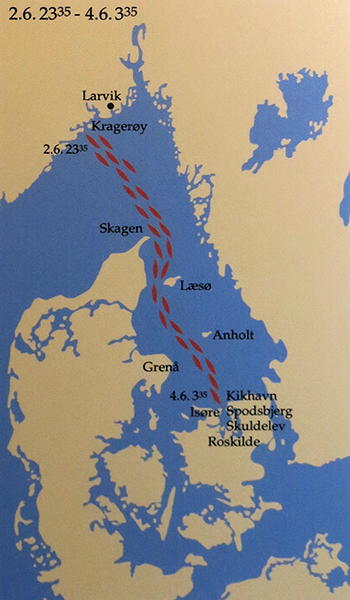
Shortly before midnight the entire fleet is under sail. The breeze is now fresh to strong (20-23 knots) and each ship rapidly picks up the pace; the attack is underway. Eleven hours later and the fleet is off Skagen from where it proceeds down more sheltered waters between Jutland and Læsø.
The wind is now moderating a little. When the fleet is off Grenâ, the wind freshens again. At Anholt the six Danish 12-sessar and one of the scout vessels are waiting. The wind now increases considerably and the crews work on the sails.
It will be a hard passage to Spodsbjerg, and the fleet sails in extended formation down towards Roskilde Fjord. By dawn, at 03.35, the leading ships pass Spodsbjerg. The wind is now from the west, backing slightly to the south at 20 knots.
The 195 nautical miles from Kragerøy to Spodsbjerg have been covered in 28 hours at an average speed of seven knots. Even though the fleet has been sighted by various fishing boats and cargo ships, there has been no danger of an early alarm reaching Denmark; the ships in the fleet are faster.
Canute and Erik's men manage to prevent the alarm being given until just before daybreak, but cannot delay it any longer. At 03.40 the beacons at Kikhavn, and Isøre are lit. Shortly afterwards the whole alarm chain is in action.
Poster and artist: Roskilde Viking Museum, Denmark
Rephotography: Don Hitchcock 2014
Source and text: Roskilde Viking Museum, Denmark
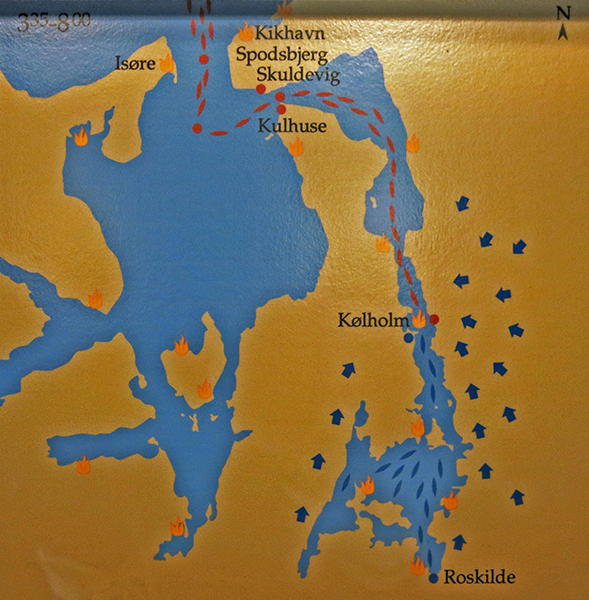
By 03.40 the advance guard is off Spodsbjerg.
Between 03.40 to 03.50 the first ships of the main fleet are off Spodsbjerg.
By 04.30 - 05.00 the remainder of the fleet, around 4 000 men, are past Spodsbjerg, and headed for the Roskilde fjord.
By this time, ground troops at Roskilde have been raised, and have been sent north on the true right of the fjord on a forced march to meet any landings by the invading force. By 05.30 relief ships are leaving Roskilde and the inner fjord.
Poster and artist: Roskilde Viking Museum, Denmark
Rephotography: Don Hitchcock 2014
Source and text: Roskilde Viking Museum, Denmark
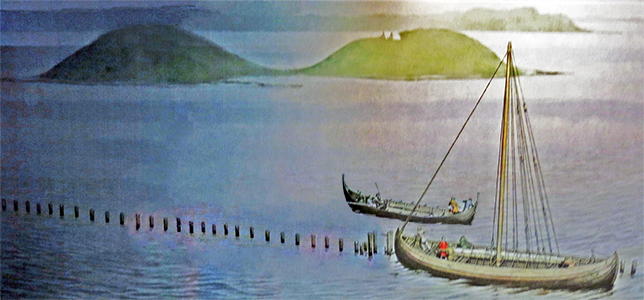
Long before, the closure of the blockade had been prepared for, by tying up to the posts of the main blockade, beside the only opening, an old boat that was no longer seaworthy, but was still suitable for the mostly calm waters of the fjord.
At time of need, rocks were ferried out to the hulk to fill it with stones and sink it in the narrow, relatively shallow channel, where it would require several hours to be cleared, even by a major attacking force, giving time for ships to come from Roskilde.
Poster and artist: Roskilde Viking Museum, Denmark
Rephotography: Don Hitchcock 2014
Source and text: Roskilde Viking Museum, Denmark
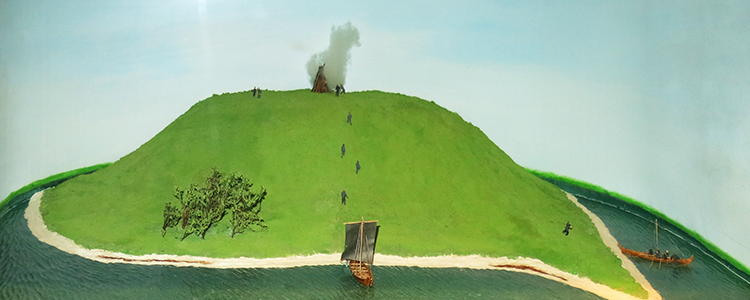
At 04.00 signals are received on the island of Kølholm. The beacon is lit and a ship is got ready with orders to seal off the Højrenden ('deep channel'), the main channel into the inner part of Roskilde Fjord, by closing in all ways possible the barrage choke point, but principally by sinking the prepared hulk across the narrow channel with stones piled up in readiness on the island and as quickly as possible loaded into the small freight vessel. After the completion of the closing of the channel, around 06.00, the men in the freight vessel stay close by but behind it, in readiness to harass the attacking force, and make it as difficult as possible for them to clear the blockage.
The small group of men on Kølholm had long abandoned the island by that time, and had sailed through the gap before its closure to reinforce the ground troops they knew would soon arrive.
Diorama and artist: Roskilde Viking Museum, Denmark
Rephotography: Don Hitchcock 2014
Source and text: Roskilde Viking Museum, Denmark
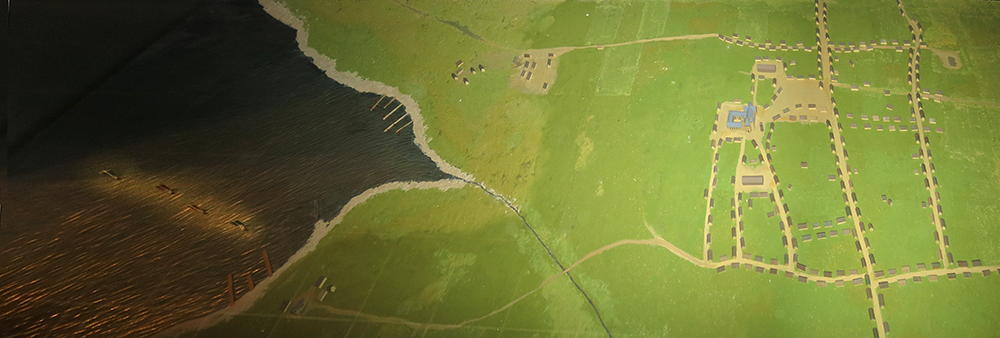
Roskilde is the centre of power in Denmark, and is well defended. As soon as the alarm beacons are seen, shortly after 04.00, ground troops are marched at the double to the site of the blockade, and ships are made ready to sail.
Diorama and artist: Roskilde Viking Museum, Denmark
Rephotography: Don Hitchcock 2014
Source and text: Roskilde Viking Museum, Denmark
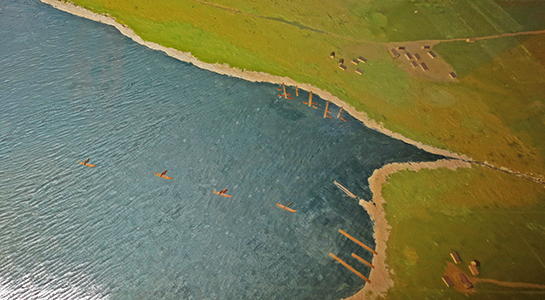
The repulse fleet sets off for the blockade about 18 km away by 05.30, while a large number of ground troops have already left.
Diorama and artist: Roskilde Viking Museum, Denmark
Rephotography: Don Hitchcock 2014
Source and text: Roskilde Viking Museum, Denmark
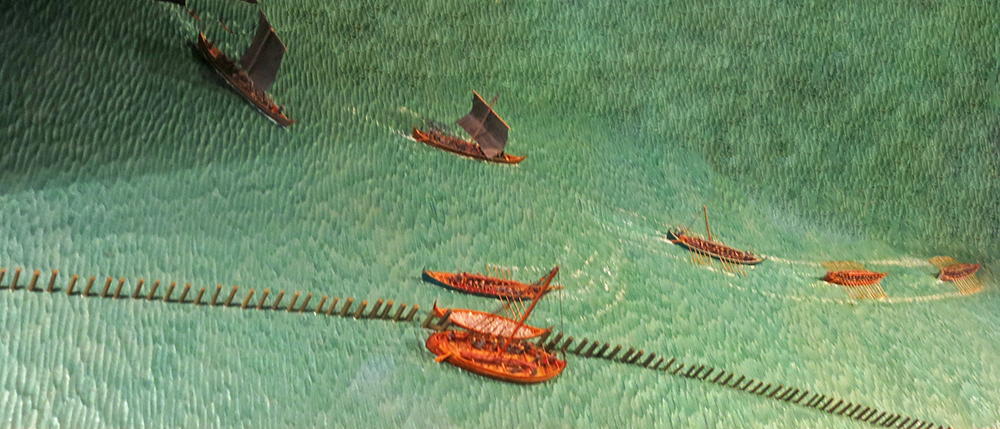
At 06.50 the blockade holds. Although one of the advance party ships turns aside to investigate whether it is possible to force the entry to Roskilde fjord, the commander decides that the cause is hopeless, he can see the sails of the approaching ships from Roskilde, and heads to a well known good landing place near present day Marbæk on the shoreline close by in order to attack Roskilde by land if possible.
Diorama and artist: Roskilde Viking Museum, Denmark
Rephotography: Don Hitchcock 2014
Source and text: Roskilde Viking Museum, Denmark um, Denmark
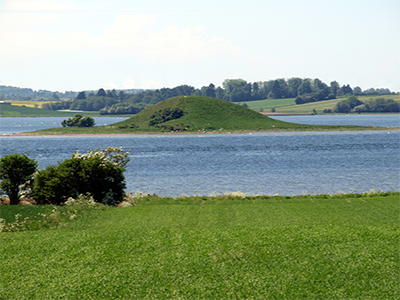
The island of Kølholm is only six hundred metres from the closest land. A channel is now kept dredged between the island and this shore.
Photo: © Olav Sejeroe via Panoramio
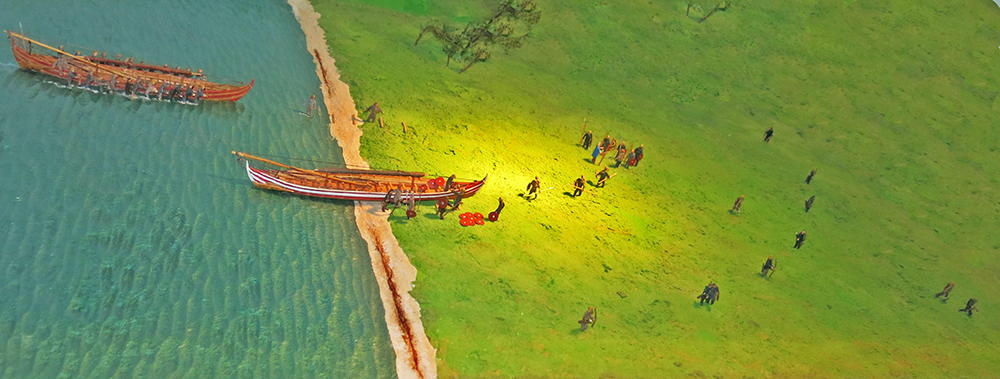
By 07.00 one boat is pulled up on the shore and is unloading, while the crew of the next is pulling their boat into the shallows after jumping into the water to lighten the load. Others are setting out rollers stored in the ship in order to get it up on dry land without damage to the hull. Meanwhile, the crew of the first start to get organised for the next part of the attack.
Diorama and artist: Roskilde Viking Museum, Denmark
Rephotography: Don Hitchcock 2014
Source and text: Roskilde Viking Museum, Denmark
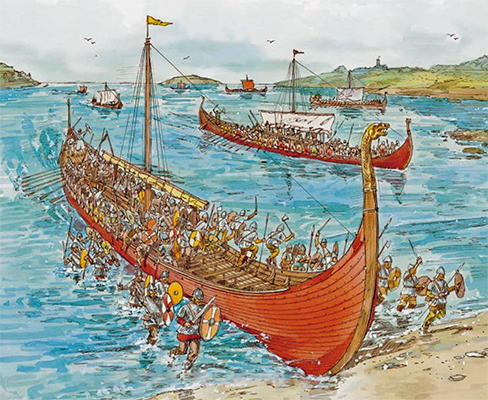
The longships combined the functions of oceangoing troop carriers and amphibious landing craft. Their remarkably shallow draft enabled longships to approach almost any beach or to invade deep inland via a waterway only a few metres deep. The more than 60 warriors on the largest ships could jump over the low side of the hull within a few strides of the land.
Photo: © Scientific American
Source and text: Scientific American February 1998
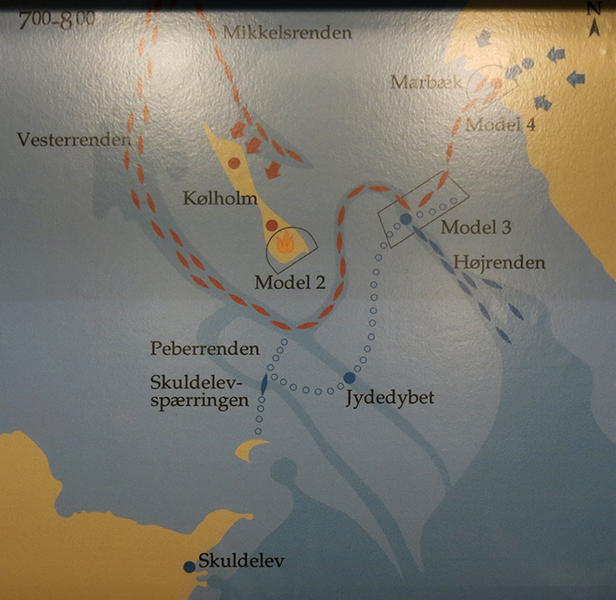
By this time the rest of the attacking ships are coming fast, and the outside part of Roskilde Fjord is full of Norwegian ships (red), while the Danish ships (blue) have by now arrived at the blockade. Something of a stalemate ensues. Most of the Danish ships now make for the shore to land their troops, leaving enough ships to maintain pressure on the blockade and stop its being breached.
By 07.40 the troops from the Danish ships are landed, and by 08.00 the ground troops from Roskilde arrive, and when reinforced with the men landed by the Danish ships, are superior in numbers. Because of the congestion in the seaways, few of the attackers have been able to land at Marbæk, and the Norwegians who have landed are forced to retreat back to their boats.
The crisis is over.
Diorama and artist: Roskilde Viking Museum, Denmark
Rephotography: Don Hitchcock 2014
Source and text: Roskilde Viking Museum, Denmark
The Roskilde Museum Canal Site Ships
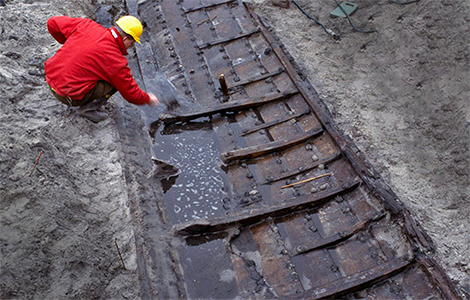
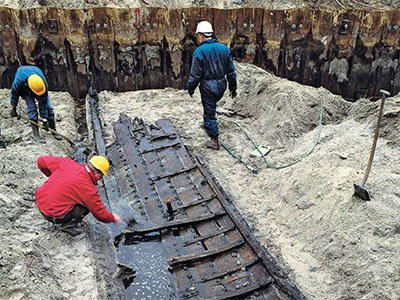
During the construction of the new Museum Island, workers discovered the remains of a massive wooden ship, now known as Roskilde 6, sunk deep in the mud of the fjord. It turned out to be the remains of the biggest Viking longboat ever found.
Photo: Roskilde Viking Museum, Denmark
Source (left) and text: http://www.theguardian.com/culture/interactive/2012/dec/27/viking-longboat-roskilde-6-interactive
Source (right): http://www.tagesspiegel.de/kultur/die-wikinger-in-berlin-koenigsschiff-vor-der-haustuer/10671662.html
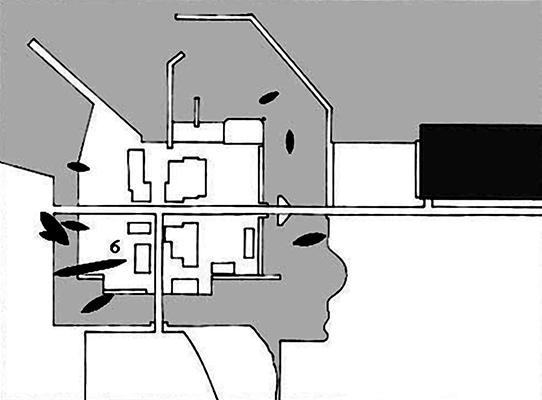
The nine ships were scattered around the area of the museum, now on an island produced by the cutting of three canals.
The find consisted of one war ship and seven cargo ships.
Photo: http://www2.rgzm.de/Navis/Home/NoFrames.htm

Diagram of the preserved sections of Roskilde 6.
(note that the source http://www.vikingeskibsmuseet.dk shows this diagram mirror-reversed, with the destroyed section on the right instead of the left.
However the orientation shown here is the correct one, as can be seen from the plan of the site above - Don )
Photo: Roskilde Viking Museum, Denmark
Source: http://www.theguardian.com/culture/interactive/2012/dec/27/viking-longboat-roskilde-6-interactive
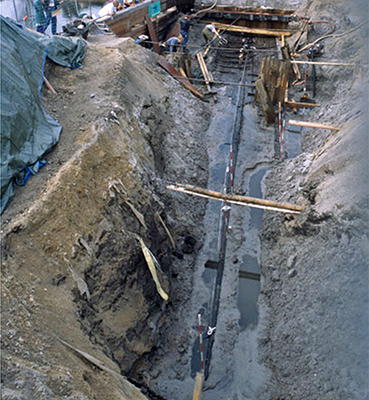
Roskilde 6 was found, together with eight other ships from Viking times and the Middle Ages during the construction of the museum harbour for the Viking Ship Museum in 1997. The ship had been hauled up into shallow water in Roskilde and partially broken up. Thus, only part of the bottom of the ship was preserved. The keel is, however, almost intact and measures 32 metres. Adding on the stem and the stern gives a total length for the whole ship of about 37 metres, the longest Viking ship yet discovered. The distance between the ribs is about 80 cm, allowing the number of oarsmen to be calculated.
There were probably 39 pairs of oars, and 78 oarsmen to serve them. A ship of this size and craftsmanship was a product of wealth and power, and was without doubt the property of a king or earl and probably one we are acquainted with from written sources. It was built sometime after 1025.
Photo: Roskilde Viking Museum, Denmark
Source: http://www.theguardian.com/culture/interactive/2012/dec/27/viking-longboat-roskilde-6-interactive
Text: http://www.vikingeskibsmuseet.dk/en/the-sea-stallion-past-and-present/longships-magnified/the-archaeological-sources/roskilde-6/#.VGb7J1drs8j
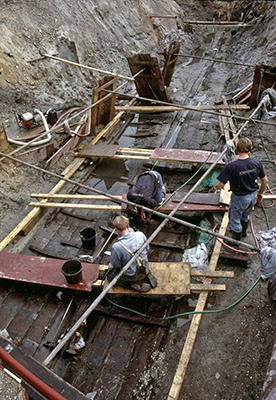
Roskilde 6, the largest longship ever found, 37 metres long, was unearthed in Roskilde, Denmark in 1997.
Photo: Werner Karrasch, Roskilde Viking Museum, Denmark
Source: http://www.vikingeskibsmuseet.dk/en/the-sea-stallion-past-and-present/longships-magnified/the-archaeological-sources/roskilde-6/#.VGbin1drs8h
Roskilde 6
| Design Element | Details |
|---|---|
| Preserved length | 32 m |
| Reconstructed length | ca 37 m |
| Preserved width | 3 m |
| Reconstructed width | 4 m |
| Preserved height | 0.7 m |
| Reconstructed height, amidships | 1.6 m |
| Reconstructed stem and stern posts | 5 m |
| No. of oars | 78 |
| Crew | 90 - 100 men |
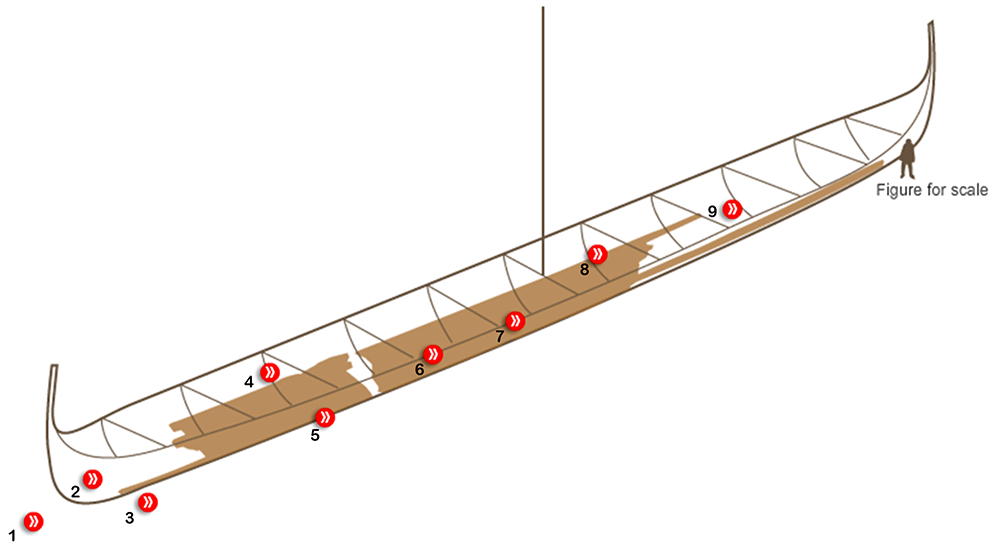
Diagram of the preserved sections of Roskilde 6, together with the layout of the original ship. The numbers represent the identification for the photographs below.
To display the timbers as they would originally have been arranged, and to give an idea of the size of the boat, the Viking Ship Museum built a steel frame to the same size and design as the original. The timbers were hung on this frame once they had been vacuum freeze dried for preservation.
The ship was taken to London, England, for an exhibition, and the steel frame was transported in about 250 separate pieces. It takes about two weeks to reassemble the structure and place the preserved timbers on the frame.
Photo: Roskilde Viking Museum, Denmark
Source: http://www.theguardian.com/culture/interactive/2012/dec/27/viking-longboat-roskilde-6-interactive
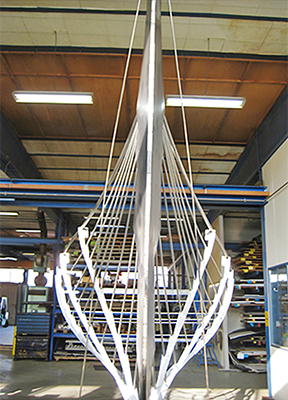
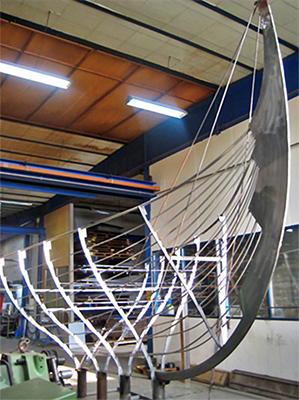
Numbers 1 and 2 in the diagram above.
Photo: Roskilde Viking Museum, Denmark
Source: http://www.theguardian.com/culture/interactive/2012/dec/27/viking-longboat-roskilde-6-interactive
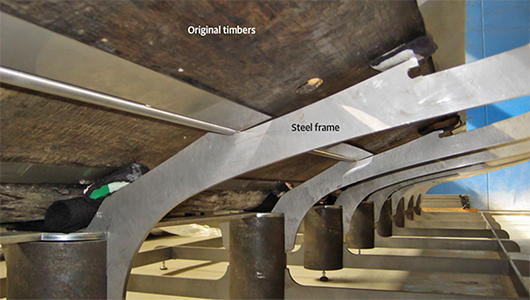
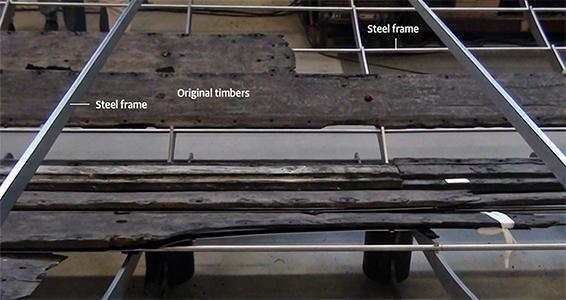
Numbers 3 and 4 in the diagram above.
Photo: Roskilde Viking Museum, Denmark
Source: http://www.theguardian.com/culture/interactive/2012/dec/27/viking-longboat-roskilde-6-interactive
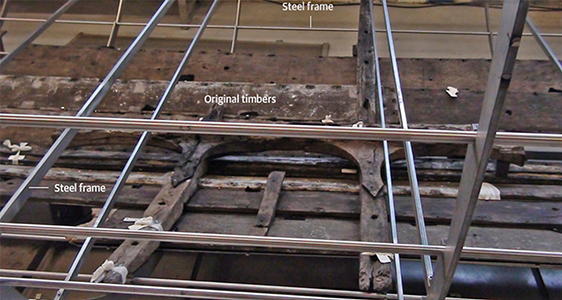
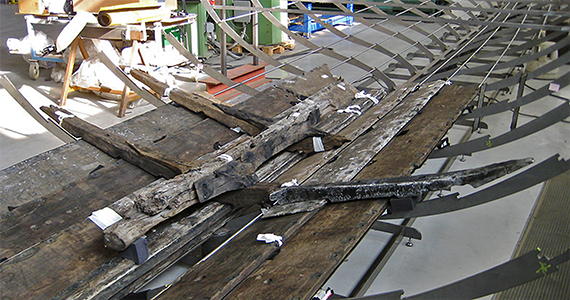
Numbers 5 and 6 in the diagram above.
Photo: Roskilde Viking Museum, Denmark
Source: http://www.theguardian.com/culture/interactive/2012/dec/27/viking-longboat-roskilde-6-interactive
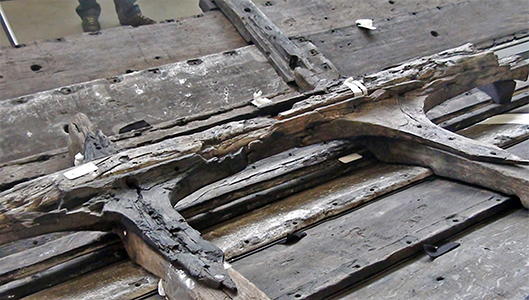
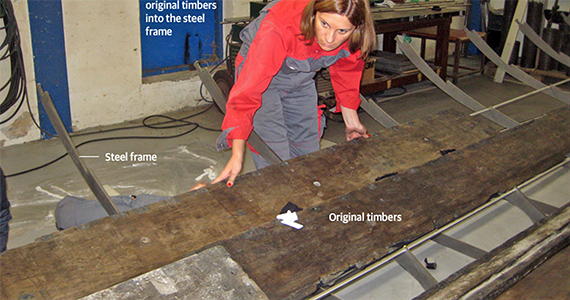
Numbers 7 and 8 in the diagram above.
Photo: Roskilde Viking Museum, Denmark
Source: http://www.theguardian.com/culture/interactive/2012/dec/27/viking-longboat-roskilde-6-interactive
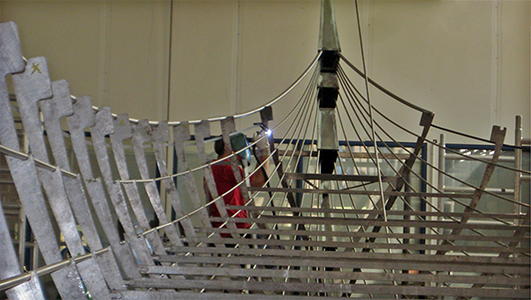
Number 9 in the diagram above.
Photo: Roskilde Viking Museum, Denmark
Source: http://www.theguardian.com/culture/interactive/2012/dec/27/viking-longboat-roskilde-6-interactive
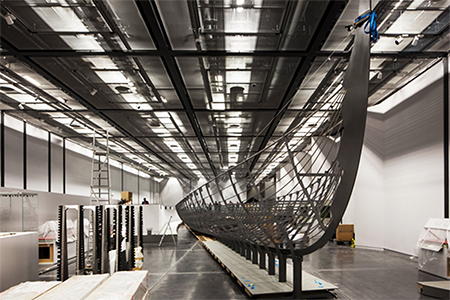
The installation of Roskilde 6 at the British Museum.
The frame is a breathtaking work of modern design in its own right. The frame has been precision engineered in dozens of individual pieces which can be loaded into a single container for shipment and reassembled under the expert handling of the NMD’s installation team. The timbers are packed flat in their own climate controlled container.
Photo: © Paul Raftery
Source and text: http://blog.britishmuseum.org/tag/roskilde/
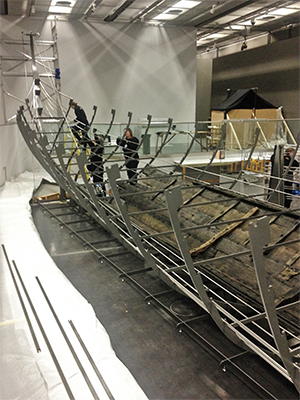
The finished installation is a wonderful marriage of modern Scandinavian design and engineering with one of the greatest technological achievements of the Viking Age.
At over 37 metres long, Roskilde 6 is the longest Viking ship ever discovered and would have been massive even by the standards of around 1025 AD, its probable date of construction. It would have taken huge amounts of manpower and raw materials to construct the ship, resources only available to the most powerful of the northern rulers. It may even have been built by Cnut himself…
Photo and text: http://blog.britishmuseum.org/tag/roskilde/
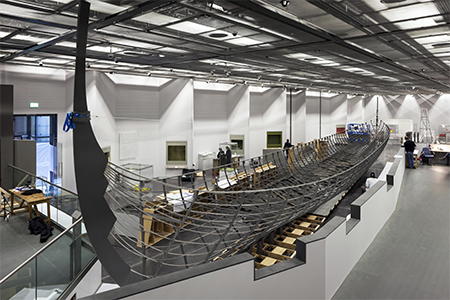
A good overview of the Viking ship installation in the British Museum.
Photo: © Paul Raftery
Source: http://www.thetolkienist.com/2014/03/07/tolkien-anglo-saxon-england-and-the-viking-exhibition-at-the-british-museum/
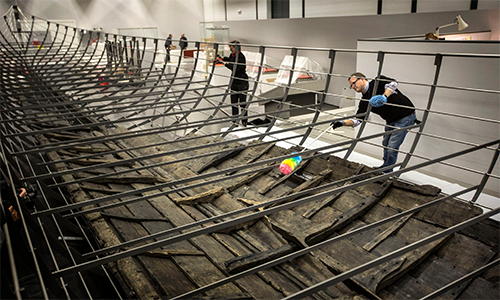
The fragile timbers of the mightiest Viking warship ever found are shown here being tenderly pieced together at the British Museum, where it was the spectacular centrepiece of the biggest Viking exhibition in a generation. Reconstructing hundreds of surviving timbers, and the steel cradle which holds them and completes the ship's long sleek outline, is considerably more straightforward than when it was built almost 1 000 years ago. In 1025 it is estimated to have taken more than 30 000 hours of work. This time, lead curator Gareth Williams received 'an enormous Meccano set' from Denmark, flatpacked in several large containers.
Williams said the ship, which will launch the museum's new exhibition space in March, was 'a war machine', a troop carrier which would have spread terror wherever it sailed. Although most of its timbers rotted over the centuries it was sunk in the silty water of the harbour at Roskilde, Denmark, the entire length of the keel survived. At almost 37 metres, it is longer than ships built centuries later, including Henry VIII's flagship, the Mary Rose. The ship may have been built for Canute, the Viking king who ruled over large parts of Scandinavia and England.
Photo: © Felix Clay for the Guardian
Source and text: http://www.theguardian.com/artanddesign/2014/jan/17/viking-warship-british-museum-exhibition
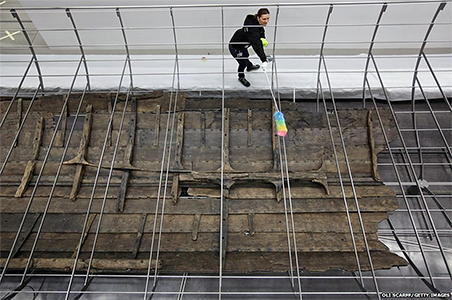
Even a thousand year old ship needs dusting occasionally!
This photo gives an excellent view of one of the best preserved parts of the hull of the ship.
Photo: © Oli Scarff / Getty Images
Source: http://www.bbc.com/news/in-pictures-25775918
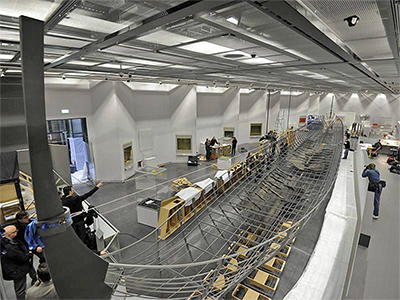
The ship was capable of 12 to 14 knots with a favourable wind. A ship like this would have taken many thousands of work hours to make.
Only the wealthiest of kings could afford such a ship - but it made him close to invincible. If you saw the sails of their ships on the horizon, they would land within half an hour.
Photo: © dpa / Facundo Arrizabalaga
Source and text: http://www.focus.de/kultur/diverses/ausstellungen-original-wikingerschiff-wird-in-berlin-aufgebaut_id_4057726.html
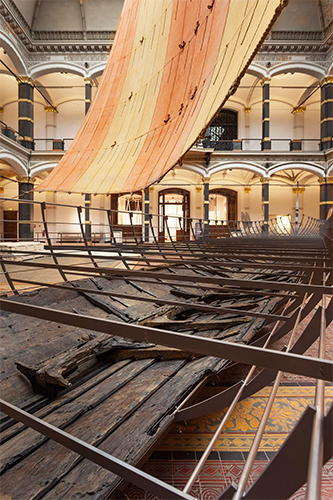
After Britain, the ship was displayed in Berlin in the atrium of the Martin-Gropius-Bau.
Photo: http://www.smb.museum/
Making a Viking Ship
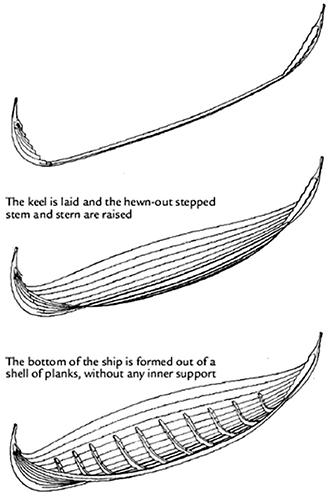
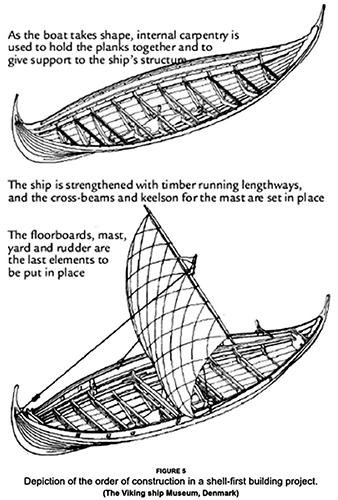
The ships were all clinker-built and fastened with riveted iron nails. The Nordic technique of building is to construct the ship's hull shell-first and to add the inner frame afterwards. Known as 'shell-first construction', it is the reverse method of the central European technique of 'skeleton-first construction'.
Photo: The Viking Ship Museum, Denmark
Source and text: Bennett (2009)
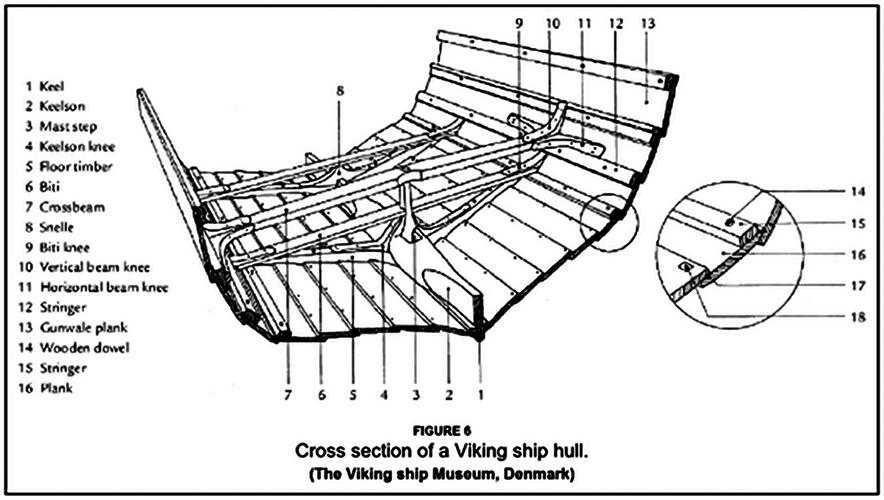
The shape of the Nordic hull is formed by stems and keel, on which the planks are clenched together to create an empty shell. The ship's shape is held by floor timbers, horizontal beams (bitis) and knees acting as transverse ribs, as well as stringers fastened to the planks with wooden dowels for longitudinal strength. Planks and ribs are cut down to the smallest possible dimensions in order to achieve flexible parts that can bend in harmony with others. Indeed, all elements of the build are designed to achieve a light, supple and flexible hull; the technique places major demands on the quality of the building material and the standard of craftsmanship.
(note that items 17 and 18 are undocumented. I believe that 17 points to the overlap between two planks, and would indicate that caulking was by sheep wool and tar, and that 18 points to an iron rivet used to hold two planks together - Don )
Photo: The Viking Ship Museum, Denmark
Source and text: Bennett (2009)
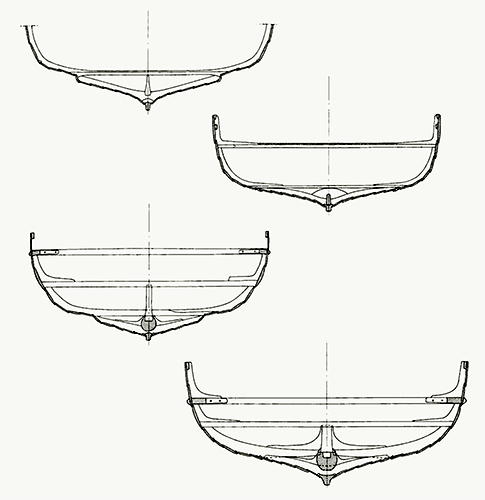
Viking ships varied greatly in size and construction. Here are shown cross-sections of a number of the best preserved vessels.
Draftsman: Sune VIllum-Nielsen, Denmark
Photo: after Sørenson (2001)
Source and text: http://www.denstoredanske.dk/Danmarks_Oldtid/Yngre_Jernalder/Et_samfund_vendt_imod_havet_800-1050_e.Kr/Med_%C3%A5rer_og_sejl
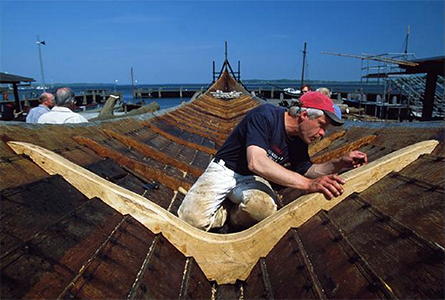
Fitting a floor timber in the longship. expertly cut to mirror the lands of the planking.
Photo: Werner Karrasch, The Viking Ship Museum, Denmark
Source and text: Bennett (2009)
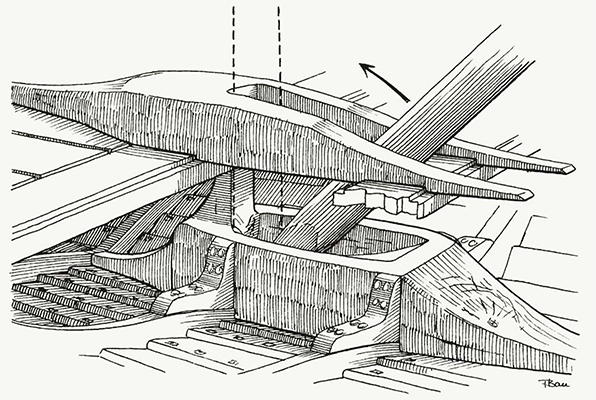
Fish (top) and hog (bottom), which support the mast and allow for it to be lowered quickly and easily when needed.
This design is from the Gokstad ship, and had been broken at one time and repaired. A different method was used in Skuldelev 2, see below.
Photo: after Olsen and Crumlin-Pedersen (1969)
Source and text: http://www.denstoredanske.dk/Danmarks_Oldtid/Yngre_Jernalder/Et_samfund_vendt_imod_havet_800-1050_e.Kr/Med_%C3%A5rer_og_sejl
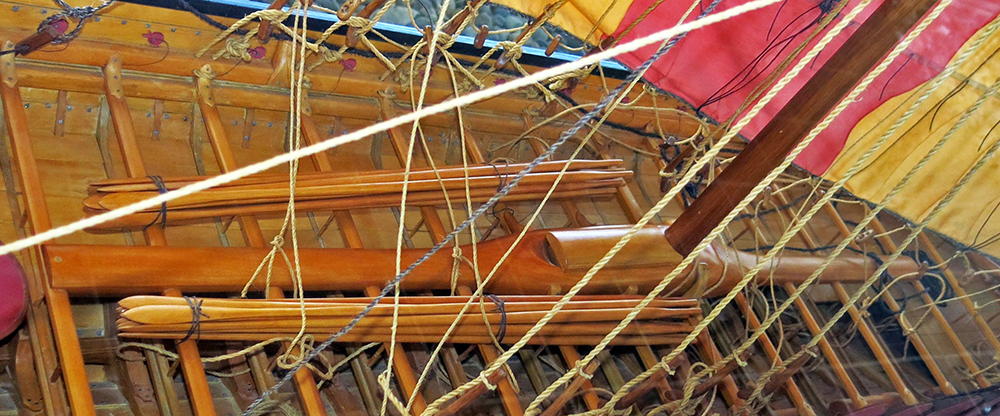
A much better designed mast support or keelson was used in Skuldelev 2. The fish and hog have been combined into one strong piece, and there is a 'chock' (there must be a nautical term!) which is inserted once the mast is raised to locate and support the base of the mast. The combined fish and hog is now much longer, so that the load is distributed over a larger part of the thwarts and keel, and with the added benefit of strengthening the whole ship. Note also that the chock can be easily removed when the mast needs to be lowered, by inserting a wooden belaying pin into the hole left at the rear of the chock and fish, and popping the chock out.
Photo and text: Don Hitchcock 2014
Source: Roskilde Viking Museum, Denmark

This is what the 13 m long keelson for Skuldelev 2 looks like in the reproduction, Havhingsten fra Glendalough.
The mast is down, and has been laid in the natural branch to the port of the ship so that it is out of the way of the rowers, and of the person at the rudder on the starboard side. For some reason it has also been lifted from the hole in the keelson as well, which should not be necessary.
Photo: © Nat I Sverige
Source: http://magellanisverige.blogspot.com.au/2006_05_01_archive.html
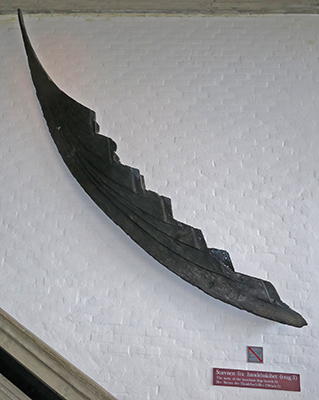
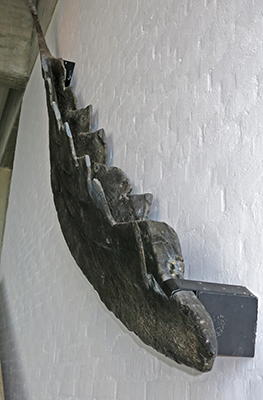
The original stem timber from Skuldelev 3
Photo: Don Hitchcock 2014
Text and source: Roskilde Viking Museum, Denmark
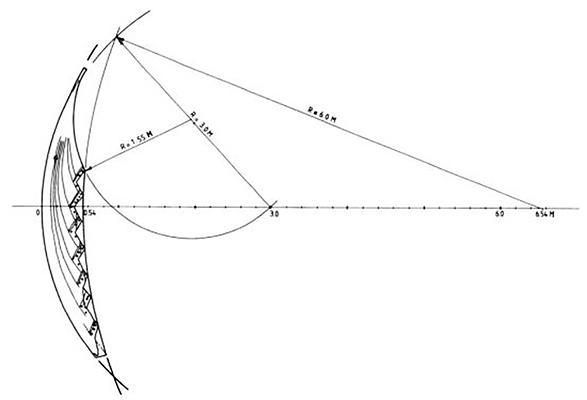
Here we may see one of the reasons for the beauty of these ships. The stem of Skuldelev 3 was defined by a system of circles with interrelated centres. The mathematics makes it beautiful to the eye.
Photo: Crumlin-Pedersen (1986)
Source: Hocker et al. (2004)
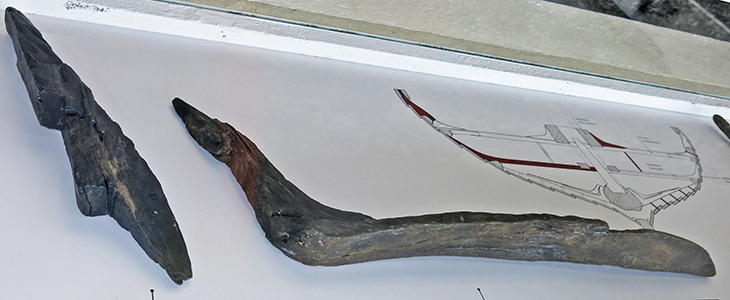
(left) Side timber
(right) Biti or cross beam with knee.
Photo: Don Hitchcock 2014
Source and text: Roskilde Viking Museum, Denmark
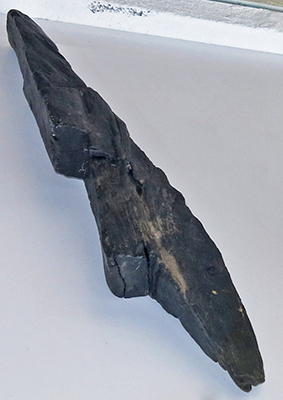
The side timber shown here from Skuldelev 2 plays an important role in the reconstruction of Skuldelev 2. It gives us an idea of the ship's height and how the uppermost strakes are placed in relation to each other. This construction detail can also be seen on the small cargo ship Skuldelev 3 and the small warship Skuldelev 5.
The original placement of the side timber in the longship Skuldelev 2 is unknown. However, based on the location in Skuldelev 3, we have reconstructed the longship with eight side timbers on each side.
Photo: Don Hitchcock 2014
Source and text: Roskilde Viking Museum, Denmark
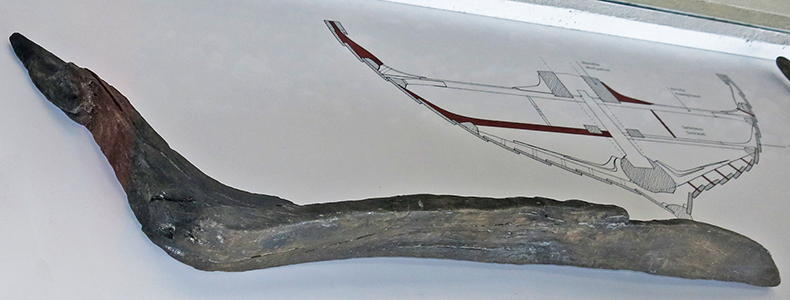
Oak biti or cross beam with knee from Skuldelev 2.
The biti includes a naturally grown knee. Both the biti and the knee that secures it to the side of the ship are made from a single tree branch.
Photo: Don Hitchcock 2014
Source and text: Roskilde Viking Museum, Denmark
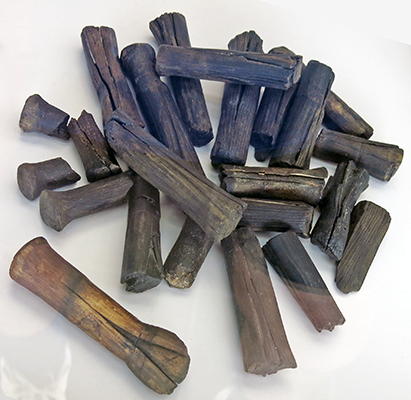
Pine or willow tree nails with wedges and broken-off treenail heads, from Skuldelev 1.
The treenails are used to secure the interior timbers or frames to the ships hull, the planking.
On the cargo vessel Skuldelev 1 the treenails are also used to secure the top strake. On the rest of the Skuldelev ships the top strake is fastened with iron rivets.
Photo: Don Hitchcock 2014
Source and text: Roskilde Viking Museum, Denmark
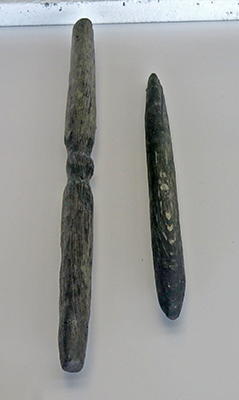
Oak thwart stanchions from one of the Skuldelev ships, with and without decoration. The stanchions support the rowing thwarts on the deck.
A thwart is a strut placed crosswise in a ship or boat to strengthen it. It can also serve as a seat for a rower. Two vertical stanchions were used per thwart, to help support the weight of the two rowers, one on each side, and give rigidity to the thwart.
Photo: Don Hitchcock 2014
Source and text: Roskilde Viking Museum, Denmark
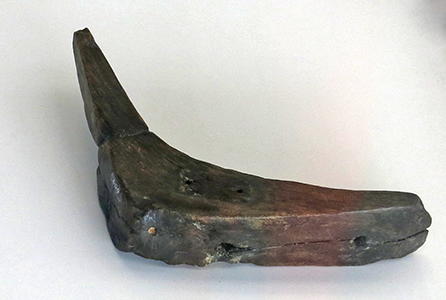
Oak knee from Skuldelev 2.
The knee is placed amidships and secures the mast partner (the mast support above the deck) to the rowing thwart.
Photo: Don Hitchcock 2014
Source and text: Roskilde Viking Museum, Denmark
Preserving the Viking Ships
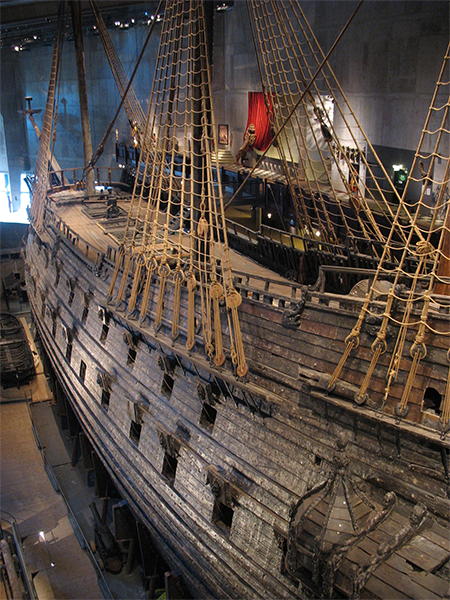
We must first go back a little, to 1628.
At that time the Vasa, a warship which took four years to build, set out on its maiden voyage. It was armed with the highest tech weaponry available in 17th-century Sweden, but the four-story, top-heavy Vasa warship sunk before it managed to sail just one nautical mile out of Stockholm’s harbour.
That was 1628.
When the ship was pulled out of the water 333 years later in 1961, archeologists found all sorts of well-preserved goodies on board, as well as a hull in excellent shape. The wood had mostly managed to avoid two major evils: Degradation via wood worms (probably because the ship had sunk when it was still brand new) and degradation via microbes (the quirky bacteria that could survive in Stockholm’s particularly polluted harbor weren’t much interested in snacking on wood).
Letting the boat dry out would have been a death sentence for the gigantic artefact, since water-logged wood tends to shrink and warp as the water evaporates away, explains Martin Nordvig Mortensen, a researcher at the National Museum of Denmark, who is studying the degradation of the Vasa's wood. (The vessel is located in Stockholm at the Vasa Museum).
Instead of letting the boat dry out, conservators sprayed the Vasa with a polymer called polyethylene glycol (PEG) until the ship was entirely saturated. (This took 17 years of spraying!) Since PEG doesn’t evaporate away upon drying, the wood is thus stabilized against warping.
Photo: Peter Isotalo
Permission: Public Domain
Text: http://cenblog.org/artful-science/2011/08/17/the-peg-in-swedens-vasa-warship/
Text below: Ek (2011)
When the Skuldelev ships were excavated in 1962, the very first timbers were treated with alum, that being the most used impregnation agent at the time. PEG was still in the experimental stage, but Brorson Christensen started his investigations on the possible use of PEG. PEG 4000, a high molecular weight form of the chemical was used for the Skuldelev ships, and was reasonably satisfactory, but it did not penetrate as much into the wood as was desirable, because of its large molecular size.
For the Roskilde ships, PEG 2000, a lower molecular weight form of the preserving agent was used, which penetrated the wood better. It acted as a stabilising agent, and acts as a cryoprotector during the freezing stage, when the wood is dried using a vacuum freeze drying process. The concentration was increased from 10% to 40% over a period of three years or more. The final impregnation was at 95% at 60° C or at 50% at 20° C depending on the degradation pattern. The drying period depended on the thickness of the objects and lasted from a few months to more than half a year.
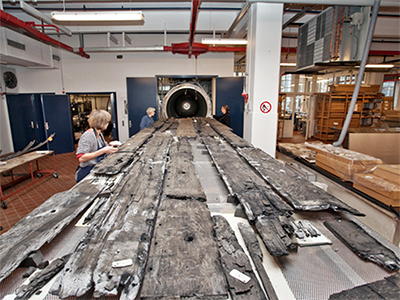
Conservation of Roskilde 6.
The Danish team of conservators and technicians, led by Kristiane Straetkvern, have been responsible for the conservation and analysis of the surviving timbers of Roskilde 6 (approx. 20% survives of the original ship), and for constructing the extraordinary stainless steel frame in which the timbers were first displayed in January 2014 in the Sainsbury Exhibitions Gallery at the British Museum.
Photo: © National Museum of Denmark (Nationalmuseet)
Source and text: http://blog.britishmuseum.org/tag/roskilde/
The pieces need to be put into moulds in order to obtain the correct shape. At the time of excavation, complete and thorough 3D measurements of all the pieces was undertaken, making this possible. The moulds and wood were placed in the vacuum freeze-dryer and frozen to about -30° C. The ice is then sublimed by vacuum freeze-drying, which takes from 4 to 6 months, depending on the thickness of the objects.
After conservation, the planks were dry, but not shaped to fit into the reconstructed ship. Moulds for each plank were prepared, and the dry, full PEG impregnated plank was placed on the mould and heated to 60° C in a humid chamber for several hours until the PEG melted and the wood became flexible. While still warm, the plank in the mould was given the correct curvature, fragments were connected with toothpicks or thin wooden and metal sticks and the wood left to cool and solidify. The plank was lifted to the supporting frame and mounted.
References
- Bennett J., 2009: Sailing into the Past: Learning from Replica Ships, Naval Institute Press (October 1, 2009)
- Olsen O., Crumlin-Pedersen O., 1969: Fem vikingeskibe fra Roskilde Fjord, Roskilde : Vikingeskibshallen i Roskilde (D.B.K.), 1969.
- Crumlin-Pedersen O., 1986: Aspects of wood technology in medieval shipbuilding, in Crumlin-Pedersen O. and Vinner M. (eds), Sailing into the past, 138-148. Roskilde: Viking Ship Museum
- Ek M., 2011: Shipwrecks 2011, Proceedings, Chemistry and Preservation of Waterlogged Wooden Shipwrecks, Royal Institute of Technology, Stockholm, 18-21 October, ISBN 978-91-7501-142-4 Editor - Monica Ek
- Hocker F., Ward A., 2004: The Philosophy of Shipbuilding: Conceptual Approaches to the Study of Wooden Ships, Texas A&M University Press, 2004 - History - 183 pages
- Palatsky E., 1962: Danish Viking Ships Expedition, Winter 1962
- Sørensen A., 2001: Ladby : a Danish ship-grave from the Viking age, Roskilde: Viking Ship Museum, 2001.
Back to Don's Maps
 Back to Archaeological Sites
Back to Archaeological Sites
